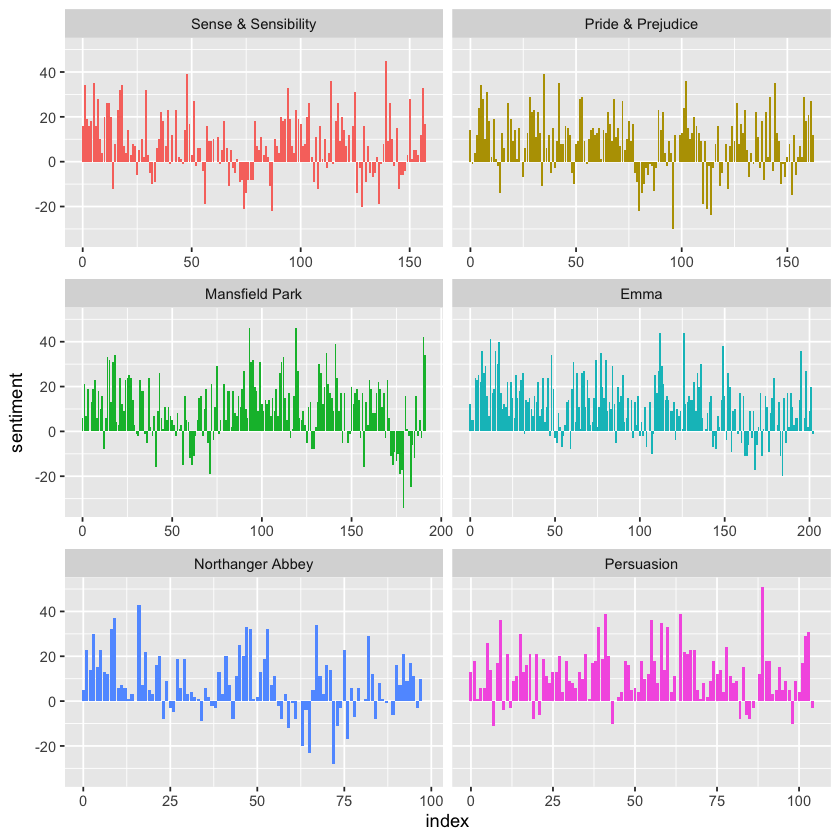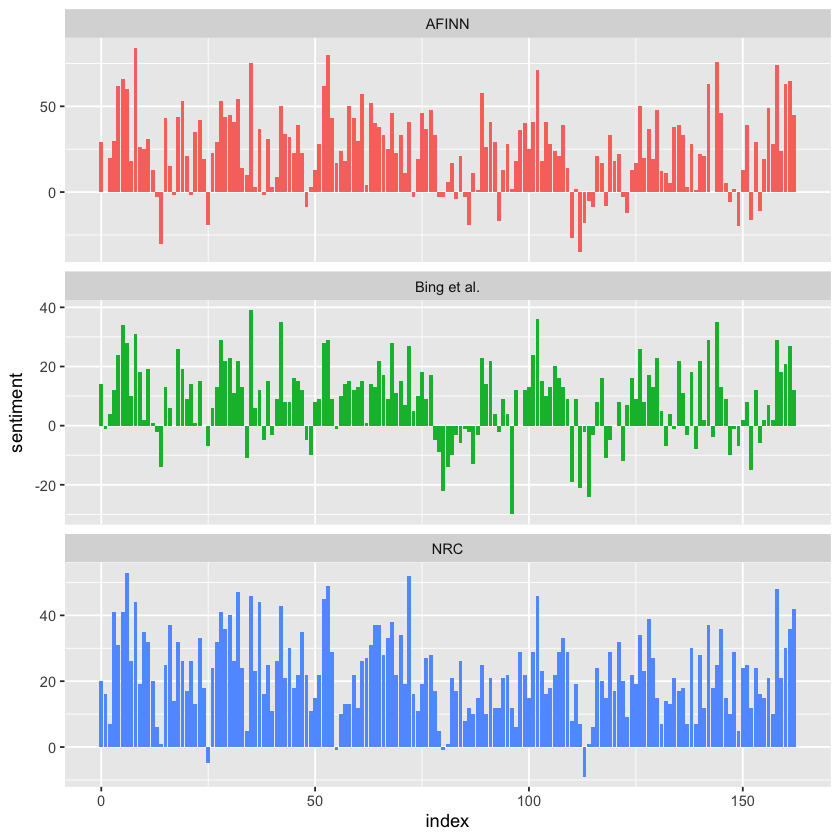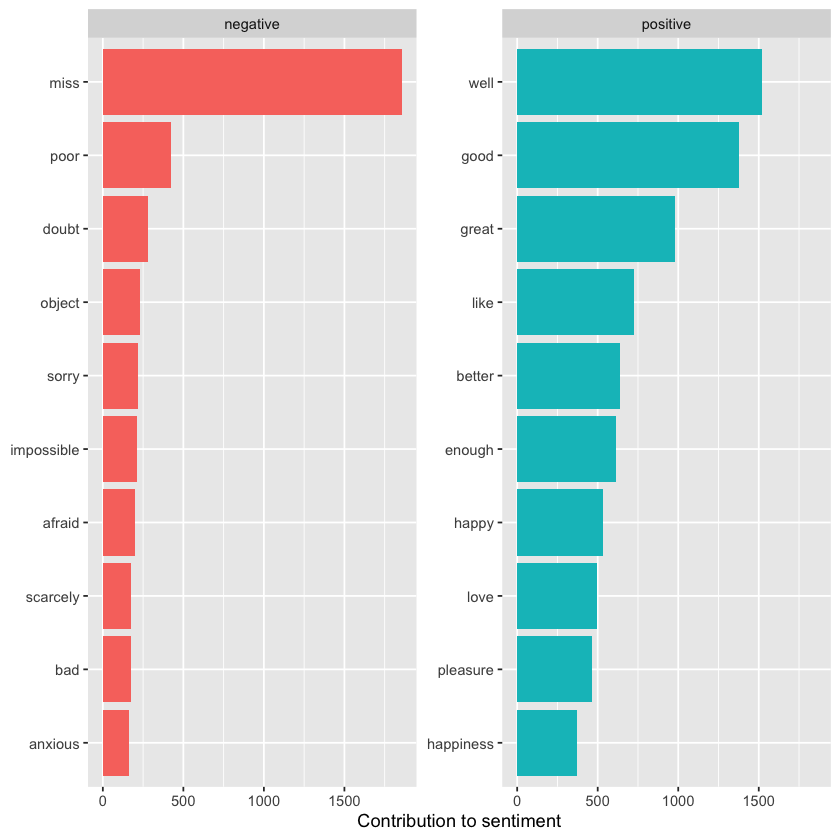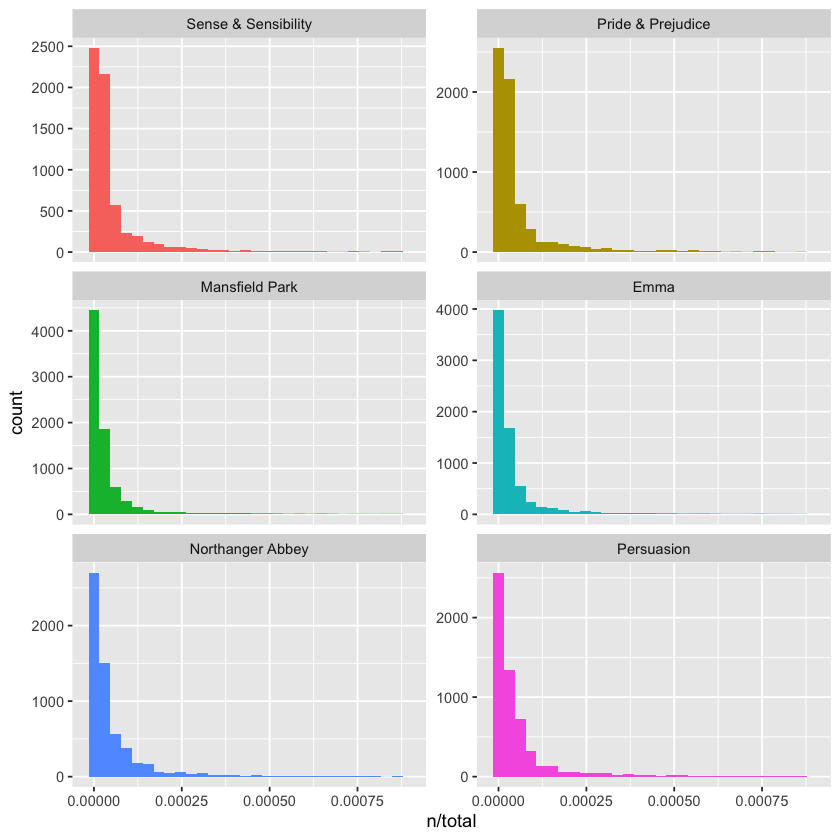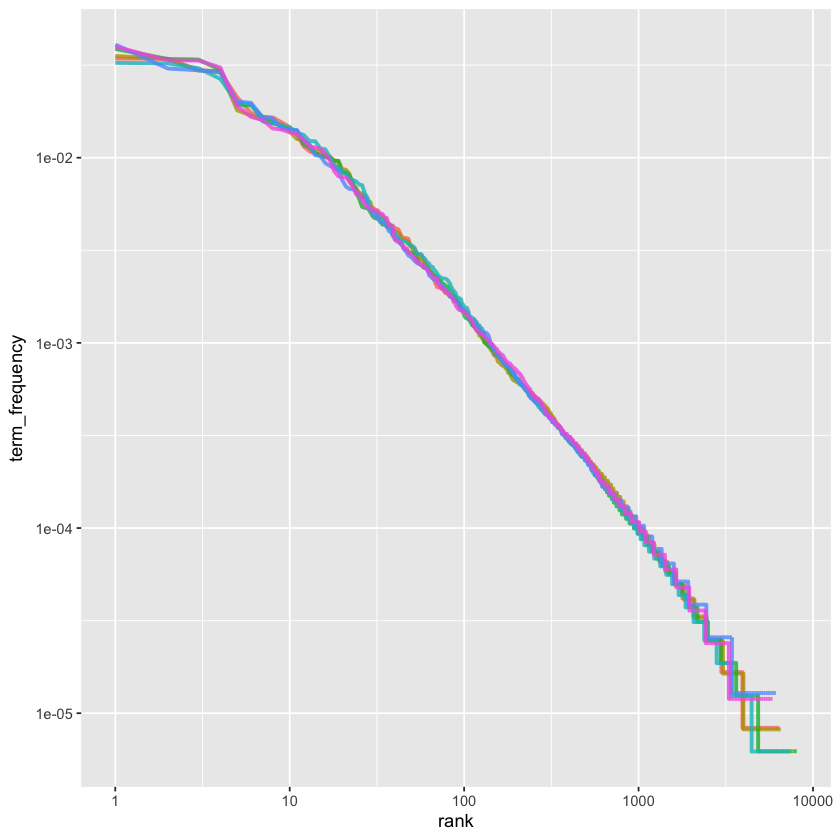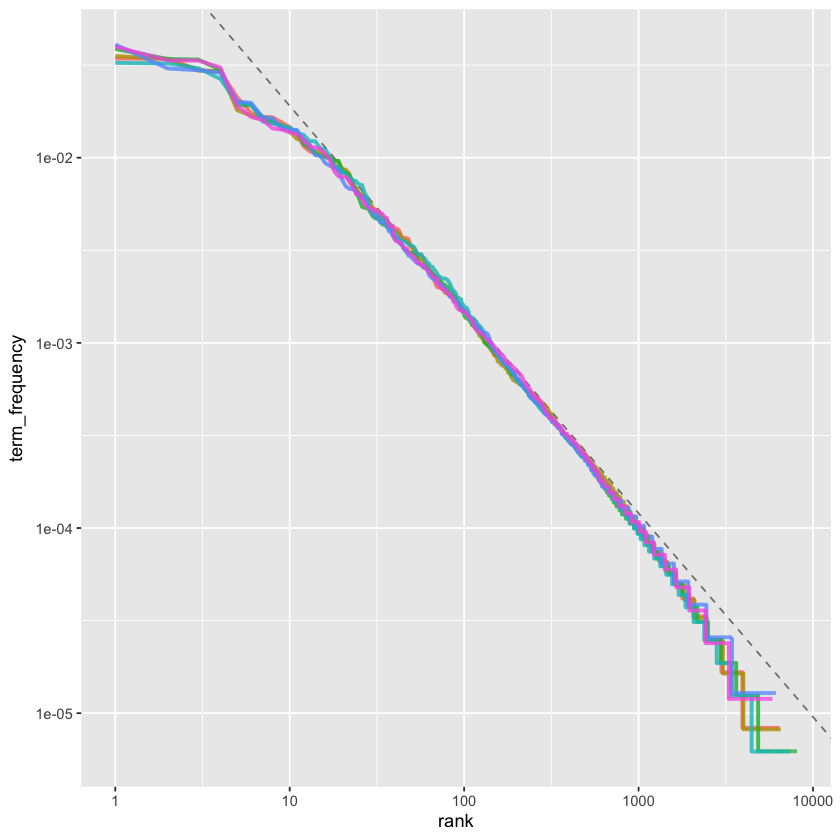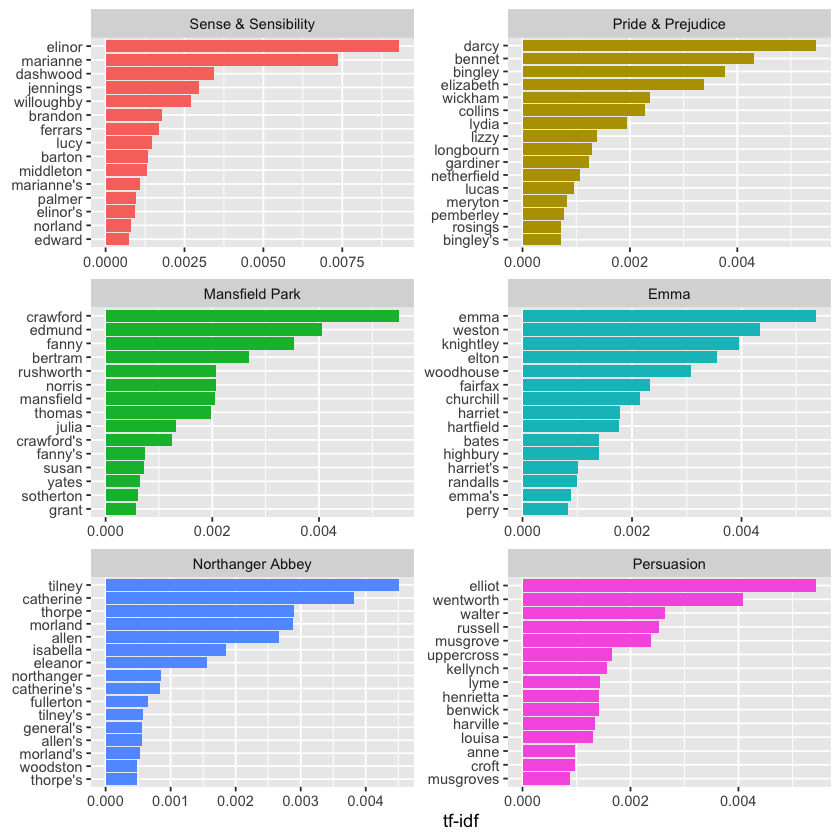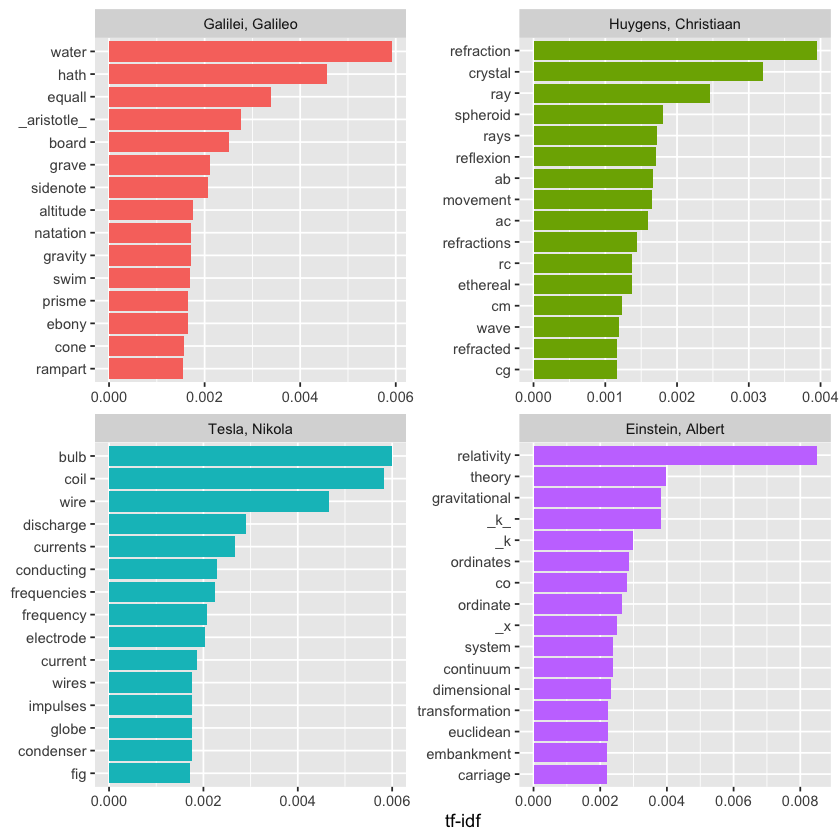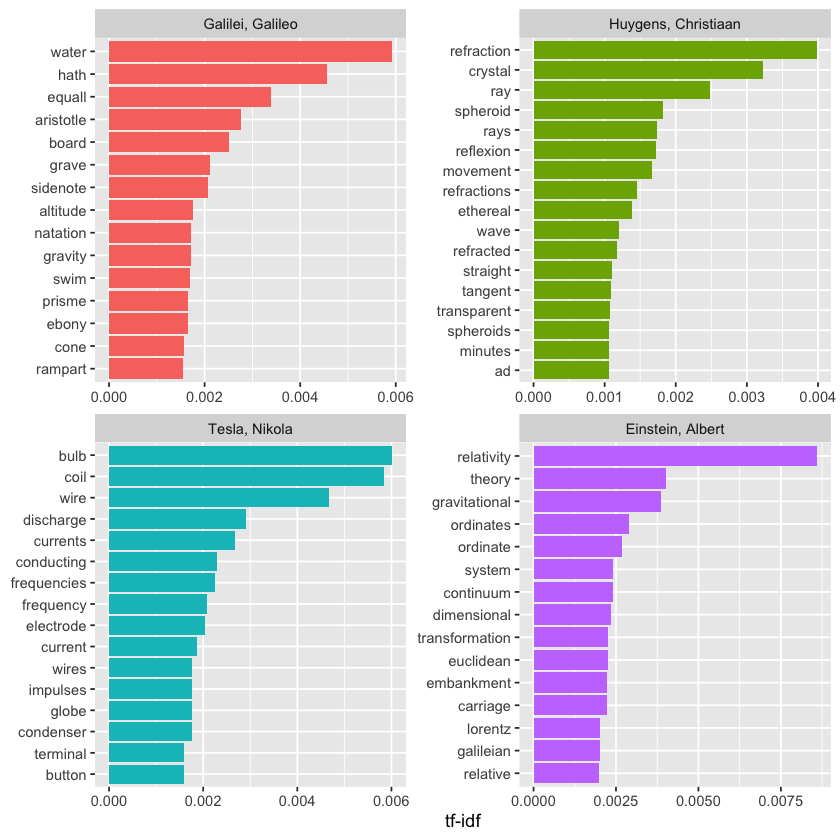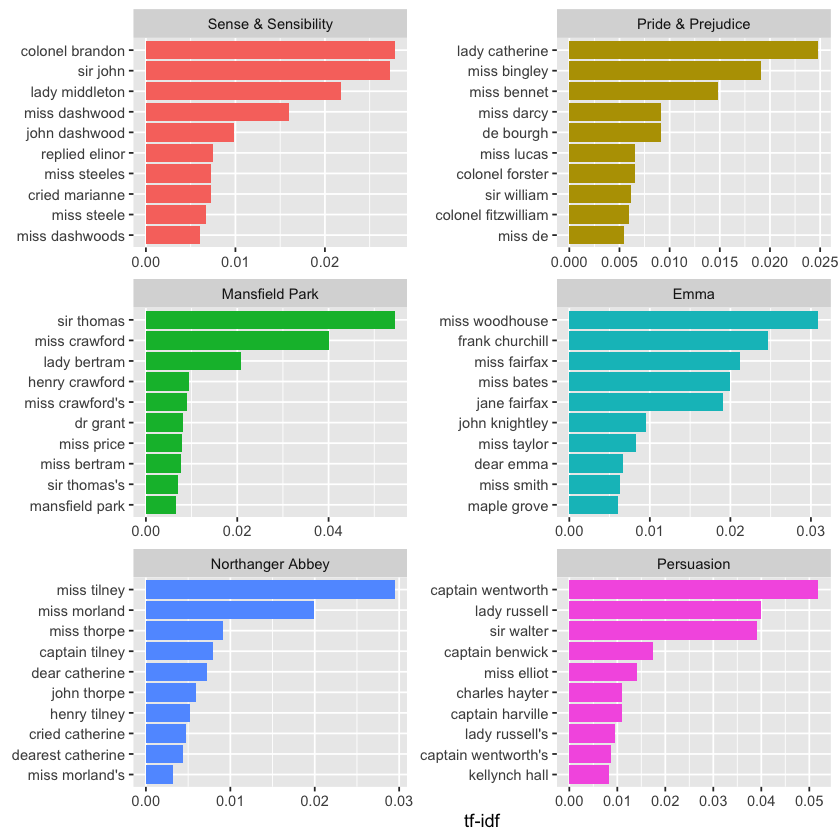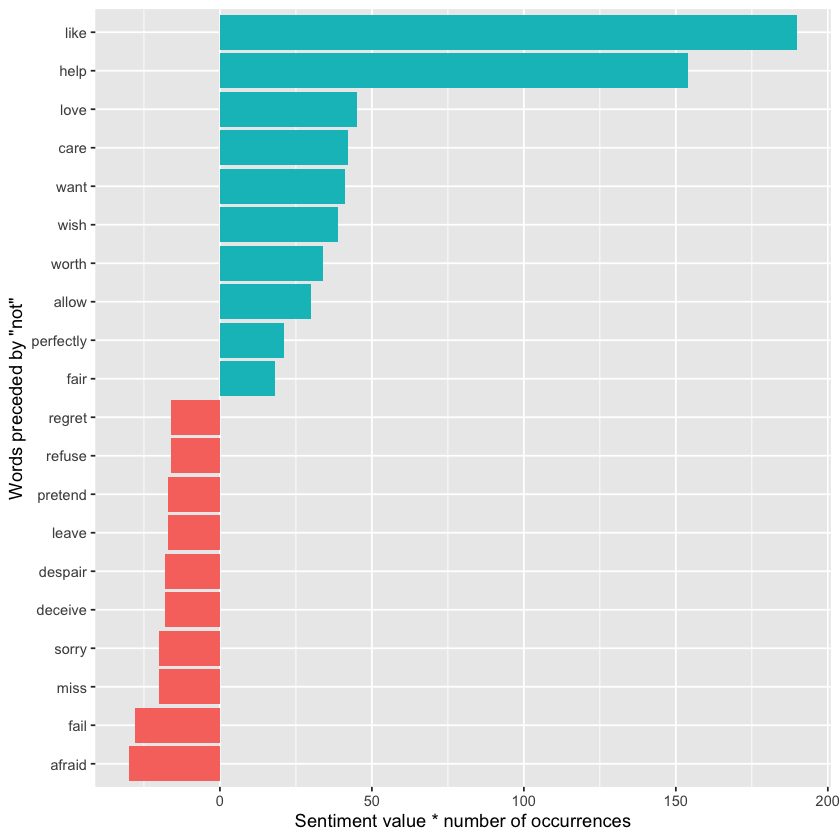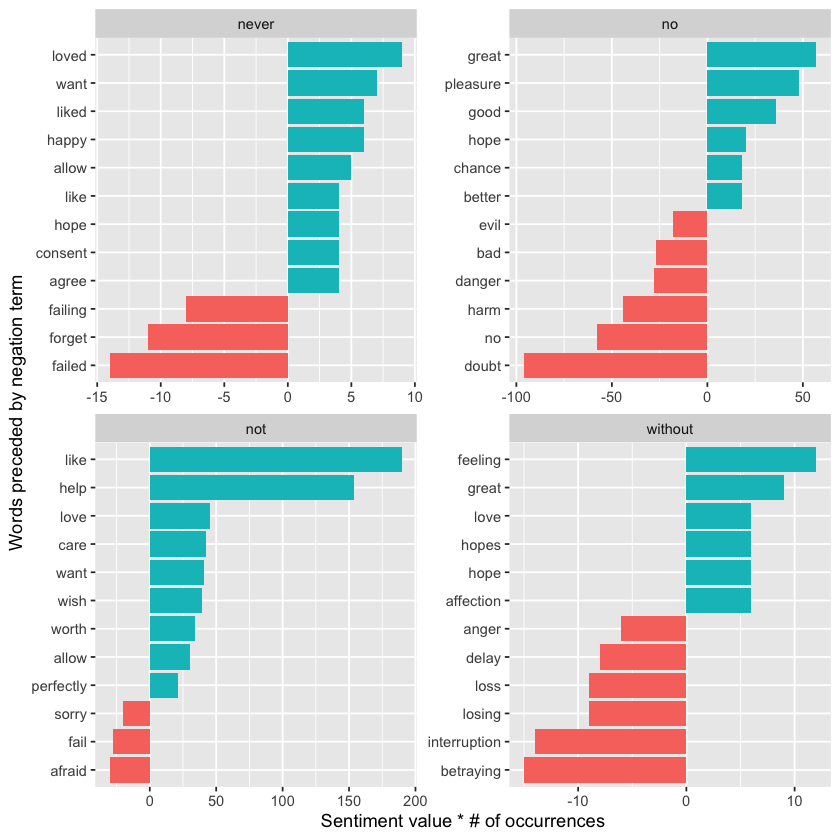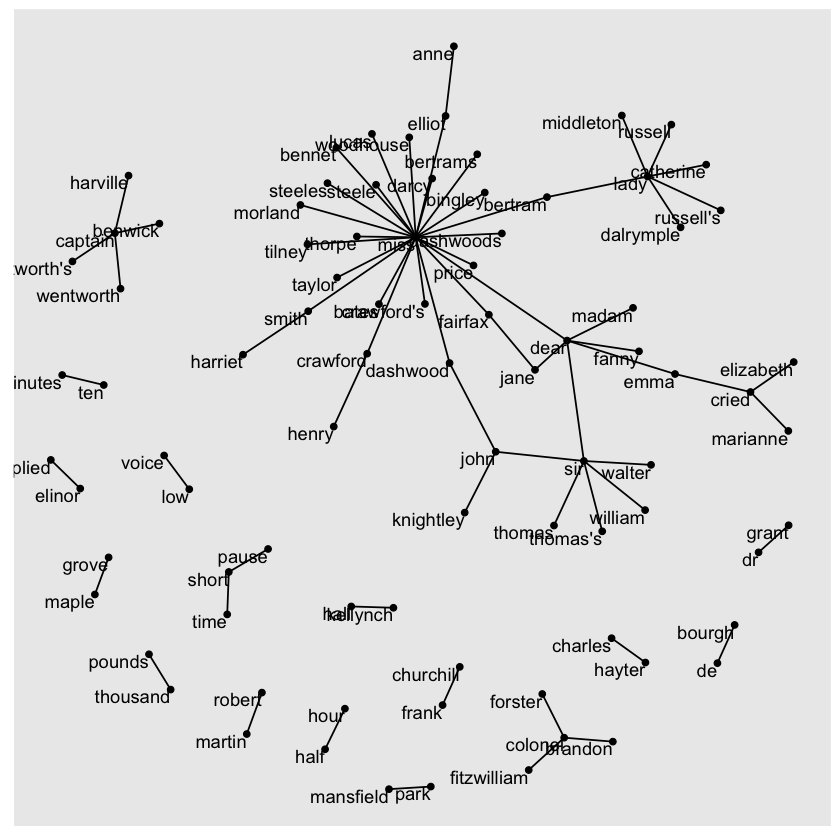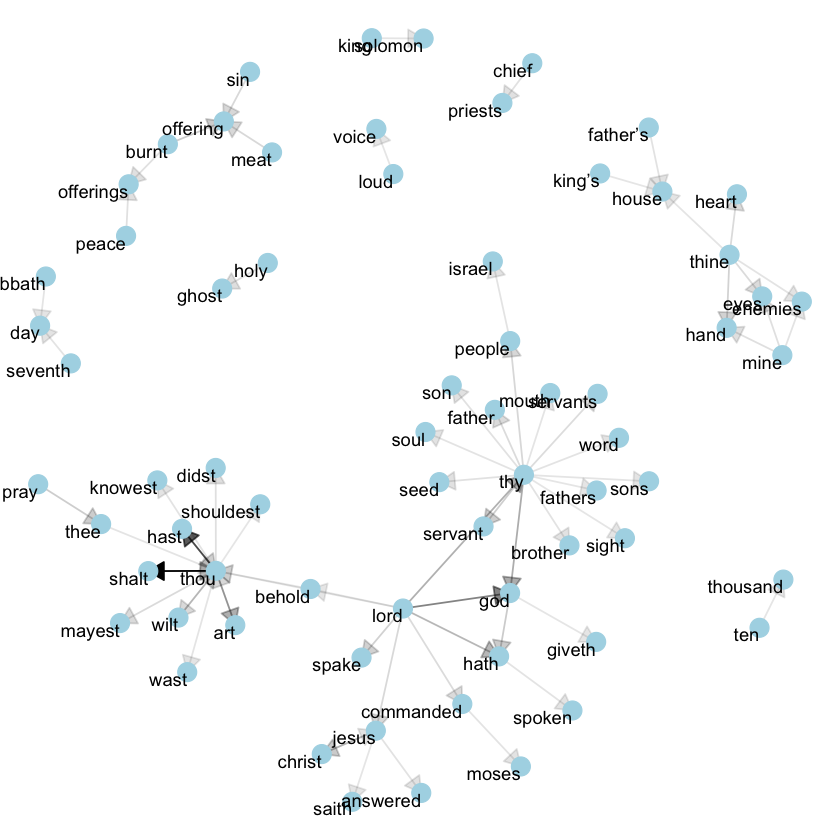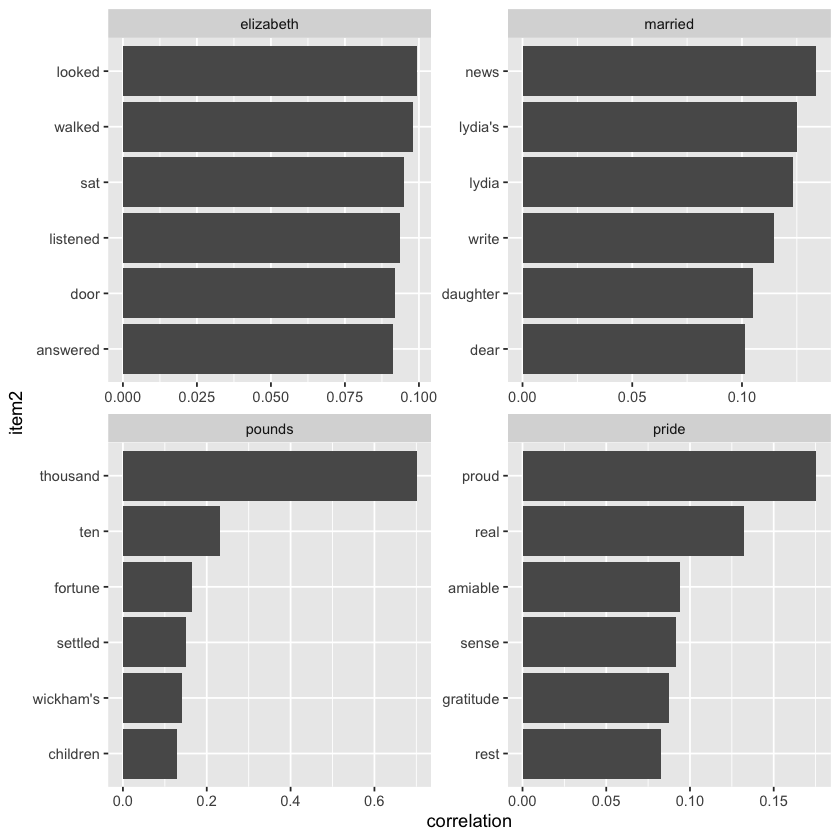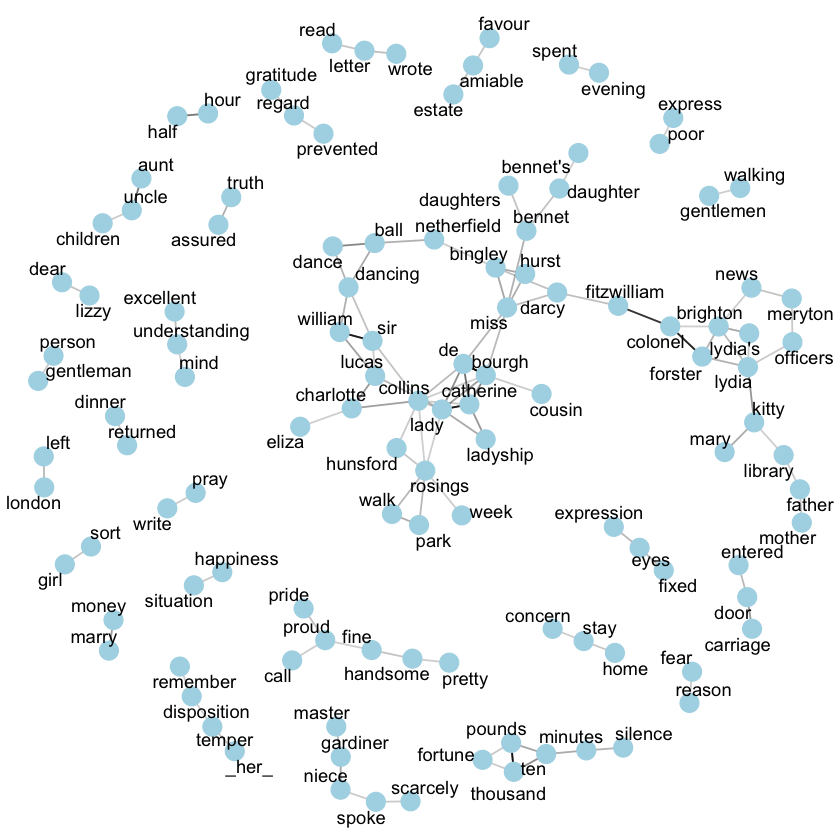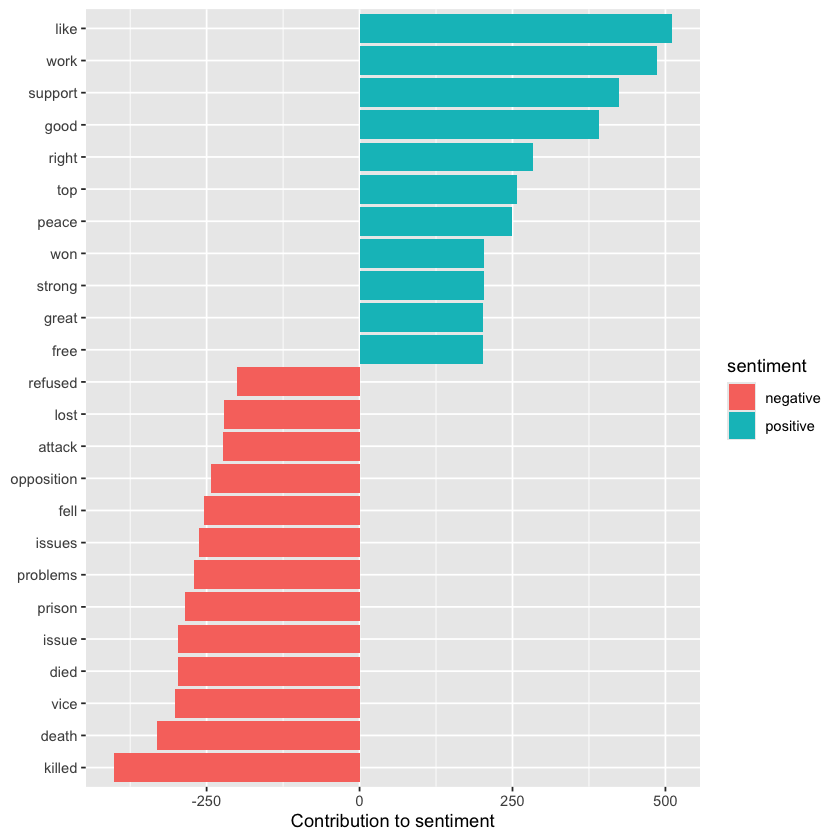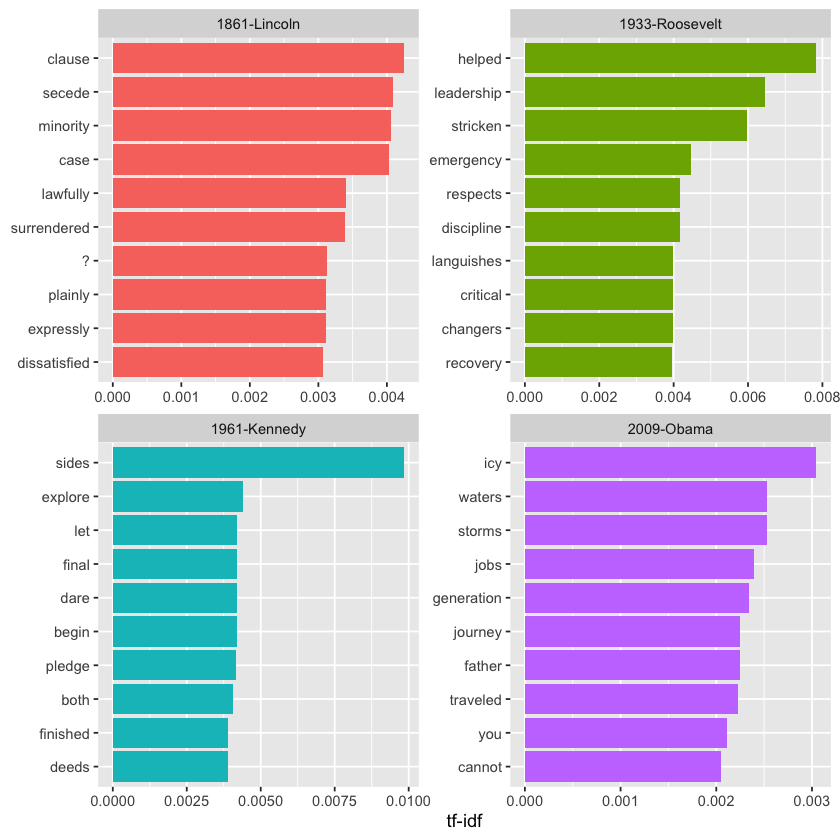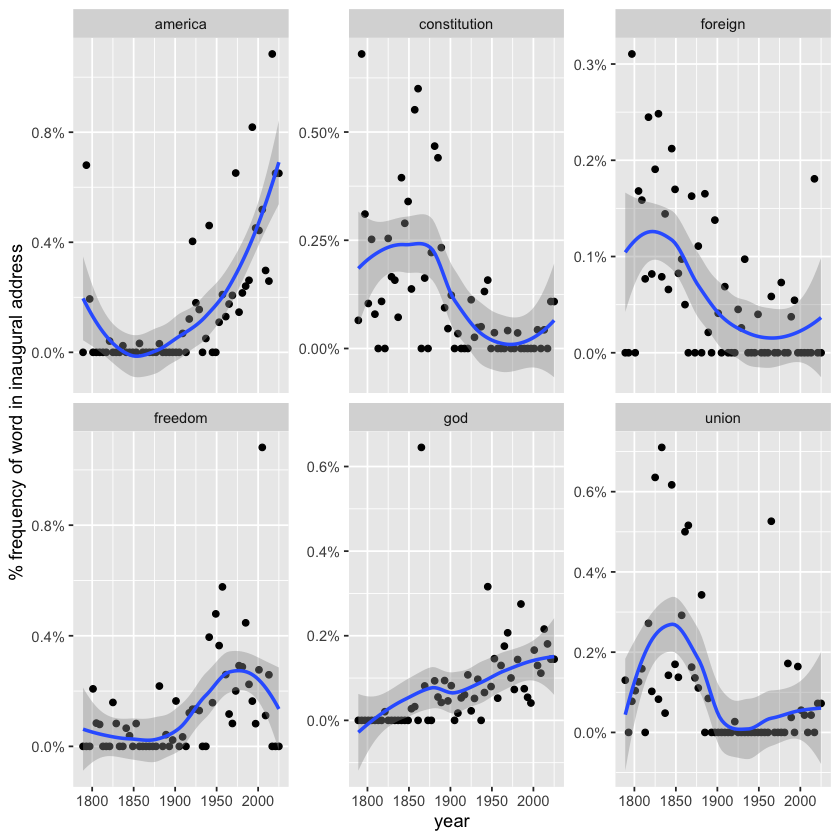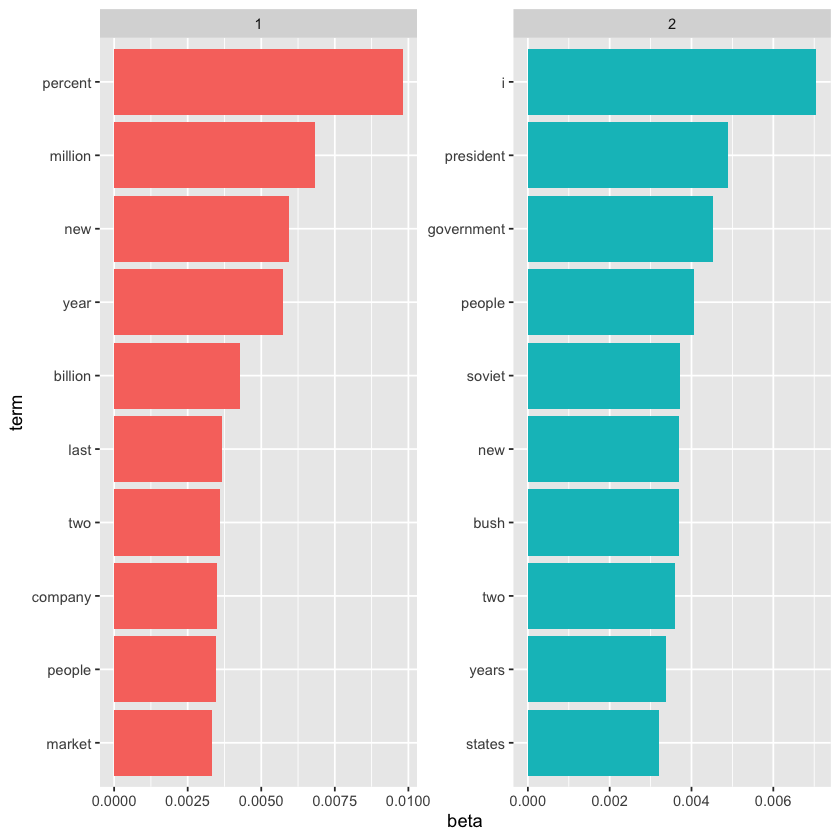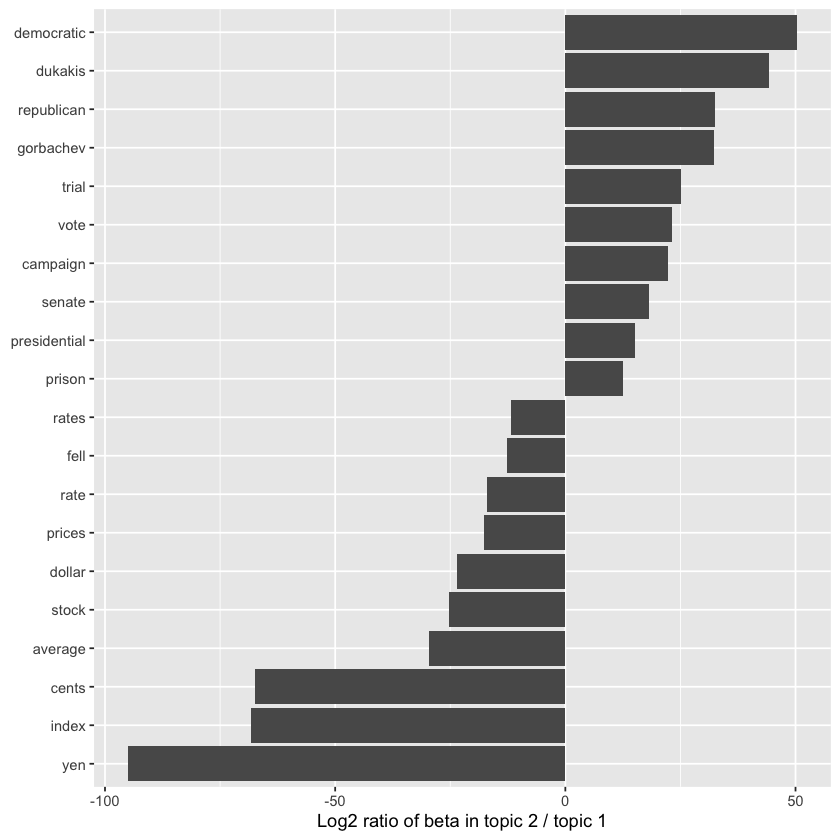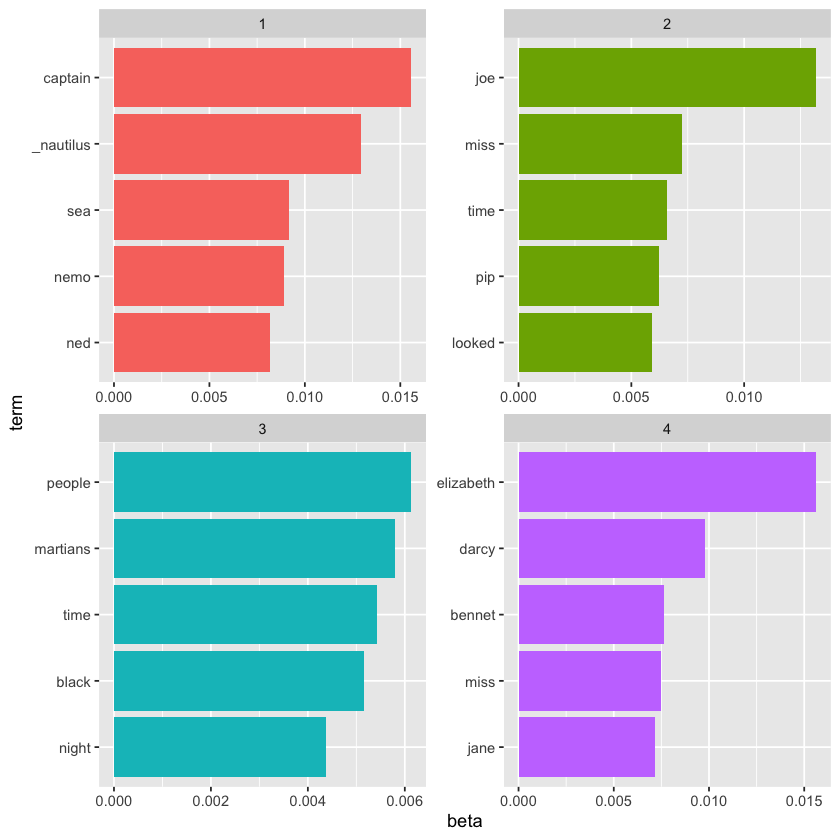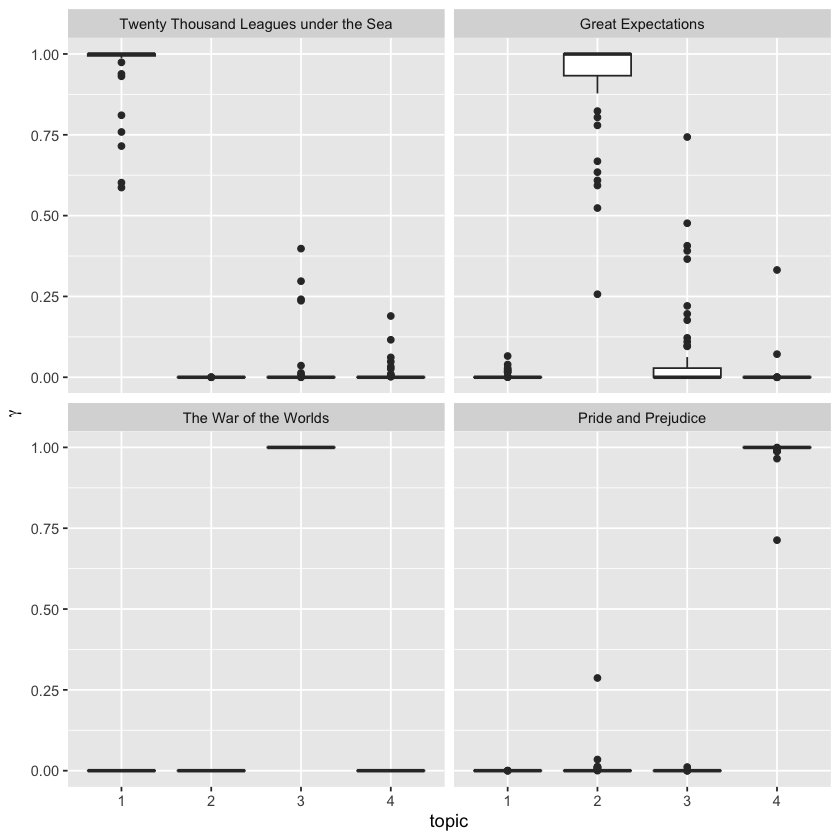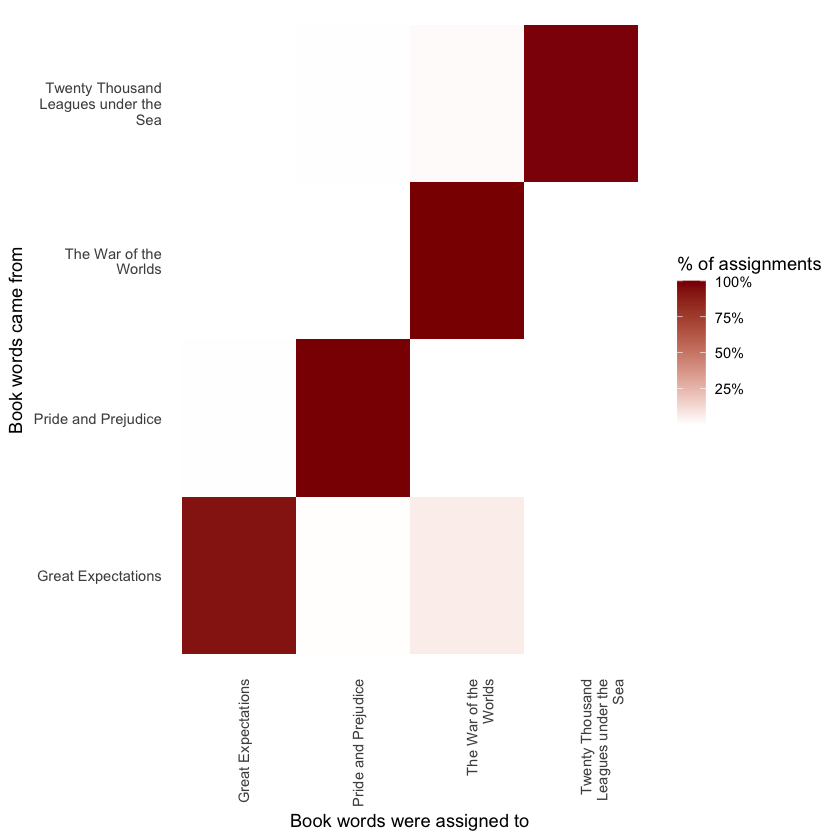Performing Analysis on Tidy Text#
Packages to Install#
install.packages("tidytext")
install.packages("textdata")
install.packages("dplyr")
install.packages("stringr")
install.packages("janeaustenr")
install.packages("wordcloud")
install.packages("reshape2")
install.packages("igraph")
install.packages("ggraph")
install.packages("widyr")
install.packages("topicmodels")
install.packages("quanteda")
install.packages("rvest")
install.packages("tibble")
install.packages("purrr")
install.packages("mallet")
install.packages("httr")
install.packages("jsonlite")
install.packages("tidyverse")
The downloaded binary packages are in
/var/folders/2h/84wxzls579b1yv00g4jj02fh0000gn/T//RtmptdIsPl/downloaded_packages
The downloaded binary packages are in
/var/folders/2h/84wxzls579b1yv00g4jj02fh0000gn/T//RtmptdIsPl/downloaded_packages
The downloaded binary packages are in
/var/folders/2h/84wxzls579b1yv00g4jj02fh0000gn/T//RtmptdIsPl/downloaded_packages
The downloaded binary packages are in
/var/folders/2h/84wxzls579b1yv00g4jj02fh0000gn/T//RtmptdIsPl/downloaded_packages
The downloaded binary packages are in
/var/folders/2h/84wxzls579b1yv00g4jj02fh0000gn/T//RtmptdIsPl/downloaded_packages
The downloaded binary packages are in
/var/folders/2h/84wxzls579b1yv00g4jj02fh0000gn/T//RtmptdIsPl/downloaded_packages
The downloaded binary packages are in
/var/folders/2h/84wxzls579b1yv00g4jj02fh0000gn/T//RtmptdIsPl/downloaded_packages
The downloaded binary packages are in
/var/folders/2h/84wxzls579b1yv00g4jj02fh0000gn/T//RtmptdIsPl/downloaded_packages
The downloaded binary packages are in
/var/folders/2h/84wxzls579b1yv00g4jj02fh0000gn/T//RtmptdIsPl/downloaded_packages
The downloaded binary packages are in
/var/folders/2h/84wxzls579b1yv00g4jj02fh0000gn/T//RtmptdIsPl/downloaded_packages
The downloaded binary packages are in
/var/folders/2h/84wxzls579b1yv00g4jj02fh0000gn/T//RtmptdIsPl/downloaded_packages
The downloaded binary packages are in
/var/folders/2h/84wxzls579b1yv00g4jj02fh0000gn/T//RtmptdIsPl/downloaded_packages
The downloaded binary packages are in
/var/folders/2h/84wxzls579b1yv00g4jj02fh0000gn/T//RtmptdIsPl/downloaded_packages
The downloaded binary packages are in
/var/folders/2h/84wxzls579b1yv00g4jj02fh0000gn/T//RtmptdIsPl/downloaded_packages
The downloaded binary packages are in
/var/folders/2h/84wxzls579b1yv00g4jj02fh0000gn/T//RtmptdIsPl/downloaded_packages
The downloaded binary packages are in
/var/folders/2h/84wxzls579b1yv00g4jj02fh0000gn/T//RtmptdIsPl/downloaded_packages
The downloaded binary packages are in
/var/folders/2h/84wxzls579b1yv00g4jj02fh0000gn/T//RtmptdIsPl/downloaded_packages
The downloaded binary packages are in
/var/folders/2h/84wxzls579b1yv00g4jj02fh0000gn/T//RtmptdIsPl/downloaded_packages
also installing the dependencies 'ps', 'sass', 'processx', 'highr', 'xfun', 'bslib', 'fontawesome', 'jquerylib', 'tinytex', 'blob', 'DBI', 'gargle', 'ids', 'rematch2', 'textshaping', 'callr', 'knitr', 'rmarkdown', 'conflicted', 'dbplyr', 'dtplyr', 'googledrive', 'googlesheets4', 'modelr', 'ragg', 'reprex'
The downloaded binary packages are in
/var/folders/2h/84wxzls579b1yv00g4jj02fh0000gn/T//RtmptdIsPl/downloaded_packages
Sentiment Analysis#
In the previous chapter, we explored the tidy text format and how it helps analyze word frequency and compare documents. Now, we shift focus to opinion mining or sentiment analysis, where we assess the emotional tone of a text. Just as human readers infer emotions like positivity, negativity, surprise, or disgust from words, we can use text mining tools to programmatically analyze a text’s emotional content. A common approach to sentiment analysis is to break the text into individual words, assign sentiment scores to those words, and sum them to understand the overall sentiment of the text. While this isn’t the only method for sentiment analysis, it is widely used and fits naturally within the tidy data framework and toolset.
The sentiments Dataset#
As discussed earlier, there are several methods and dictionaries available for evaluating opinion or emotion in text. The tidytext package provides access to three commonly used general-purpose sentiment lexicons: AFINN, developed by Finn Årup Nielsen; bing, from Bing Liu and collaborators; and nrc, created by Saif Mohammad and Peter Turney. All three lexicons are based on unigrams, meaning they assign sentiment scores to individual words. The nrc lexicon categorizes words as positive, negative, or into specific emotions like joy, anger, sadness, and trust, using a simple “yes”/”no” system. The bing lexicon also applies a binary positive or negative label to each word, while the AFINN lexicon assigns numerical sentiment scores ranging from -5 (most negative) to 5 (most positive). These lexicons are distributed under different licenses, so it’s important to review the terms and ensure they align with your project requirements before use.
The get_sentiments() function allows us to easily access specific sentiment lexicons along with their corresponding sentiment measures. By specifying the lexicon name (such as "afinn", "bing", or "nrc"), we can retrieve the appropriate set of words and their sentiment scores or categories, making it straightforward to incorporate sentiment analysis into a tidy text workflow.
library(tidytext)
print(get_sentiments("afinn"))
# A tibble: 2,477 x 2
word value
<chr> <dbl>
1 abandon -2
2 abandoned -2
3 abandons -2
4 abducted -2
5 abduction -2
6 abductions -2
7 abhor -3
8 abhorred -3
9 abhorrent -3
10 abhors -3
# i 2,467 more rows
print(get_sentiments("bing"))
# A tibble: 6,786 x 2
word sentiment
<chr> <chr>
1 2-faces negative
2 abnormal negative
3 abolish negative
4 abominable negative
5 abominably negative
6 abominate negative
7 abomination negative
8 abort negative
9 aborted negative
10 aborts negative
# i 6,776 more rows
print(get_sentiments("nrc"))
# A tibble: 13,872 x 2
word sentiment
<chr> <chr>
1 abacus trust
2 abandon fear
3 abandon negative
4 abandon sadness
5 abandoned anger
6 abandoned fear
7 abandoned negative
8 abandoned sadness
9 abandonment anger
10 abandonment fear
# i 13,862 more rows
The sentiment lexicons used in text mining were developed through either crowdsourcing platforms like Amazon Mechanical Turk or the manual effort of individual researchers, and they were validated using datasets such as crowdsourced opinions, movie or restaurant reviews, or Twitter posts. Because of this, applying these lexicons to texts that differ greatly in style or era—like 200-year-old narrative fiction—may produce less precise results, although shared vocabulary still allows meaningful sentiment analysis. In addition to these general-purpose lexicons, domain-specific options exist, such as those designed for financial texts. These dictionary-based methods work by summing the sentiment scores of individual words but have limitations, as they don’t account for context, qualifiers, or negation (e.g., “not good”). For many types of narrative text where sarcasm or constant negation is minimal, this limitation is less significant, though later chapters explore strategies for handling negation. It’s also important to choose an appropriate text chunk size for analysis—large text sections can have sentiment scores that cancel each other out, whereas sentence- or paragraph-level analysis often yields clearer results.
Sentiment Analysis with Inner Join#
When text data is in a tidy format, performing sentiment analysis becomes as simple as using an inner join. This highlights one of the key advantages of approaching text mining as a tidy data task—the tools and workflows remain consistent and intuitive. Just as removing stop words involves an anti_join, sentiment analysis works by applying an inner_join to combine the tokenized text with a sentiment lexicon, matching words in the text to their corresponding sentiment values. This tidy approach simplifies the process and integrates seamlessly with other tidyverse functions.
To find the most common joy-related words in Emma using the NRC lexicon, we first need to convert the novel’s text into a tidy format with one word per row, using unnest_tokens(), just like we did earlier. To preserve important context, we can also create additional columns that track which line and chapter each word appears in. This is done using group_by() to organize the text by book and mutate() to assign line numbers and detect chapters, often using a regular expression. Once the text is structured this way, we can easily filter for words associated with joy in the NRC lexicon and analyze their frequency within the novel.
Notice that we named the output column from unnest_tokens() as word, which is a practical and consistent choice. The sentiment lexicons and stop word datasets provided by tidytext also use word as the column name for individual tokens. By keeping this naming consistent, performing operations like inner_join() for sentiment analysis or anti_join() for removing stop words becomes straightforward and seamless, avoiding unnecessary renaming or data wrangling.
library(janeaustenr)
library(dplyr)
library(stringr)
tidy_books <- austen_books() %>%
group_by(book) %>%
mutate(
linenumber = row_number(),
chapter = cumsum(str_detect(text,
regex("^chapter [\\divxlc]",
ignore_case = TRUE)))) %>%
ungroup() %>%
unnest_tokens(word, text)
Notice that we named the output column from unnest_tokens() as word. This is a convenient choice, as both the sentiment lexicons and stop word lists use word as their column name, making joins and filtering operations much simpler.
With the text now in a tidy format—one word per row—we’re ready to run sentiment analysis. We’ll start by using the NRC lexicon and applying filter() to select only the words associated with joy. Then, we’ll filter the book text for words from Emma and use inner_join() to connect it to the sentiment lexicon. To see the most common joy-related words in Emma, we can apply count() from dplyr.
nrc_joy <- get_sentiments("nrc") %>%
filter(sentiment == "joy")
tidy_books %>%
filter(book == "Emma") %>%
inner_join(nrc_joy) %>%
count(word, sort = TRUE) %>%
print()
Joining with `by = join_by(word)`
# A tibble: 301 x 2
word n
<chr> <int>
1 good 359
2 friend 166
3 hope 143
4 happy 125
5 love 117
6 deal 92
7 found 92
8 present 89
9 kind 82
10 happiness 76
# i 291 more rows
We mostly see positive, uplifting words about hope, friendship, and love here. There are also some words that Austen may not have intended to sound joyful, like “found” or “present”; we’ll look at this issue more closely in Section 2.4.
We can also explore how sentiment shifts throughout each novel. This requires only a few lines of code, mostly using dplyr functions. First, we assign a sentiment score to each word by joining the Bing lexicon with our text using inner_join().
Next, we count the number of positive and negative words within set sections of the text. To do this, we create an index to track our position in the narrative; this index uses integer division to group the text into sections of 80 lines each.
The %/% operator performs integer division (x %/% y is the same as floor(x/y)), allowing us to track which 80-line section we are analyzing for positive and negative sentiment.
If sections are too small, we might not have enough words to reliably estimate sentiment, while sections that are too large can blur the narrative structure. For these novels, 80-line sections work well, though the ideal size depends on factors like the length of the text and how the lines were structured originally. Finally, we use pivot_wider() to separate positive and negative sentiment into different columns and calculate the net sentiment by subtracting negative from positive.
library(tidyr)
jane_austen_sentiment <- tidy_books %>%
inner_join(get_sentiments("bing")) %>%
count(book, index = linenumber %/% 80, sentiment) %>%
pivot_wider(names_from = sentiment, values_from = n, values_fill = 0) %>%
mutate(sentiment = positive - negative)
Joining with `by = join_by(word)`
Warning message in inner_join(., get_sentiments("bing")):
"Detected an unexpected many-to-many relationship between `x` and `y`.
i Row 435443 of `x` matches multiple rows in `y`.
i Row 5051 of `y` matches multiple rows in `x`.
i If a many-to-many relationship is expected, set `relationship =
"many-to-many"` to silence this warning."
Now that we’ve calculated sentiment scores for sections of each novel, we can visualize how sentiment changes over the course of the story. To do this, we plot the sentiment scores against the index on the x-axis, which represents the narrative timeline divided into sections of text.
This approach lets us clearly see how the emotional tone of each novel rises or falls, revealing points where the story shifts toward more positive or negative sentiment as the plot progresses. This provides a useful, high-level overview of the emotional structure of the narrative.
Comparing Sentiment Dictionaries#
With multiple sentiment lexicons available, it’s helpful to compare them to determine which best suits your analysis. To explore this, we can apply all three sentiment lexicons—AFINN, bing, and nrc—and examine how each captures sentiment changes across the narrative arc of Pride and Prejudice.
We start by using filter() to isolate only the words from Pride and Prejudice so we can focus the analysis on that specific text. From there, we can apply each lexicon to compare how sentiment patterns emerge using different approaches.
pride_prejudice <- tidy_books %>%
filter(book == "Pride & Prejudice")
print(pride_prejudice)
# A tibble: 122,204 x 4
book linenumber chapter word
<fct> <int> <int> <chr>
1 Pride & Prejudice 1 0 pride
2 Pride & Prejudice 1 0 and
3 Pride & Prejudice 1 0 prejudice
4 Pride & Prejudice 3 0 by
5 Pride & Prejudice 3 0 jane
6 Pride & Prejudice 3 0 austen
7 Pride & Prejudice 7 1 chapter
8 Pride & Prejudice 7 1 1
9 Pride & Prejudice 10 1 it
10 Pride & Prejudice 10 1 is
# i 122,194 more rows
We can now use inner_join() to apply the different sentiment lexicons and calculate sentiment scores throughout the novel. It’s important to remember that the AFINN lexicon assigns words a numeric score ranging from -5 (strongly negative) to 5 (strongly positive), while the bing and nrc lexicons categorize words simply as positive or negative.
Because of these differences, we use slightly different approaches when calculating sentiment for each lexicon. For all three, we divide the text into larger sections using integer division (%/%), grouping lines together to capture sentiment trends over meaningful chunks of the narrative. We then apply count(), pivot_wider(), and mutate() to compute net sentiment in each section, allowing for a clear comparison of how sentiment evolves across the novel using each lexicon’s unique scoring method.
afinn <- pride_prejudice %>%
inner_join(get_sentiments("afinn")) %>%
group_by(index = linenumber %/% 80) %>%
summarise(sentiment = sum(value)) %>%
mutate(method = "AFINN")
bing_and_nrc <- bind_rows(
pride_prejudice %>%
inner_join(get_sentiments("bing")) %>%
mutate(method = "Bing et al."),
pride_prejudice %>%
inner_join(get_sentiments("nrc") %>%
filter(sentiment %in% c("positive",
"negative"))
) %>%
mutate(method = "NRC")) %>%
count(method, index = linenumber %/% 80, sentiment) %>%
pivot_wider(names_from = sentiment,
values_from = n,
values_fill = 0) %>%
mutate(sentiment = positive - negative)
Joining with `by = join_by(word)`
Joining with `by = join_by(word)`
Joining with `by = join_by(word)`
Warning message in inner_join(., get_sentiments("nrc") %>% filter(sentiment %in% :
"Detected an unexpected many-to-many relationship between `x` and `y`.
i Row 215 of `x` matches multiple rows in `y`.
i Row 5178 of `y` matches multiple rows in `x`.
i If a many-to-many relationship is expected, set `relationship =
"many-to-many"` to silence this warning."
We now have calculated the net sentiment—positive minus negative—for each chunk of the novel text using all three sentiment lexicons: AFINN, bing, and nrc. The next step is to bind these results together into a single data frame so we can easily compare them side by side. Once combined, we can visualize the sentiment trends across the narrative using a plot. This allows us to directly observe how each lexicon captures emotional shifts in the story and highlights both the similarities and differences in their sentiment patterns.
bind_rows(afinn,
bing_and_nrc) %>%
ggplot(aes(index, sentiment, fill = method)) +
geom_col(show.legend = FALSE) +
facet_wrap(~method, ncol = 1, scales = "free_y")
The three sentiment lexicons produce different absolute results, but they reveal similar overall sentiment patterns across the novel. All three show comparable peaks and dips in sentiment at roughly the same points in the story, reflecting consistent emotional shifts. However, the AFINN lexicon tends to produce the largest absolute values, with higher positive and negative extremes. The bing lexicon shows smaller absolute values and often identifies longer stretches of consistently positive or negative text. Meanwhile, the NRC lexicon shifts the sentiment scores higher overall, labeling more of the text as positive but still capturing similar relative sentiment changes. These patterns are consistent across other novels as well: NRC sentiment tends to be higher, AFINN shows more variability, and Bing highlights longer contiguous blocks of sentiment, but all three lexicons generally agree on the broader narrative sentiment trends.
The NRC lexicon often produces higher overall sentiment scores compared to the Bing et al. lexicon because of differences in how the two are constructed. One key reason is that the NRC lexicon contains a larger proportion of positive words relative to negative words, which biases its overall sentiment scores upward. To better understand this, we can look at the actual counts of positive and negative words within each lexicon. By comparing how many words are labeled positive versus negative in both the NRC and Bing lexicons, we can see why the NRC results tend to skew more positive, even when both detect similar relative sentiment shifts across a text.
get_sentiments("nrc") %>%
filter(sentiment %in% c("positive", "negative")) %>%
count(sentiment) %>%
print()
# A tibble: 2 x 2
sentiment n
<chr> <int>
1 negative 3316
2 positive 2308
get_sentiments("bing") %>%
count(sentiment) %>%
print()
# A tibble: 2 x 2
sentiment n
<chr> <int>
1 negative 4781
2 positive 2005
Both the NRC and Bing lexicons actually contain more negative words than positive ones, but the Bing lexicon has a higher ratio of negative to positive words compared to NRC. This difference helps explain why the Bing lexicon tends to produce lower overall sentiment scores, while the NRC lexicon often skews more positive. Additionally, systematic differences in how well the lexicons’ negative words match the vocabulary of a particular author—like Jane Austen—can further influence the results. Despite these absolute differences, the lexicons generally show similar relative sentiment trajectories and changes in narrative slope across the text. This context is important to keep in mind when selecting a sentiment lexicon, as the choice can impact both the magnitude and interpretation of sentiment analysis results.
Most Common Positive and Negative Words#
One advantage of having a tidy data frame that includes both sentiment labels and individual words is that it allows us to directly analyze which words contribute to positive or negative sentiment. By using `count() with both the word and sentiment columns as arguments, we can quickly see how often each word appears in the text and how it contributes to either positive or negative sentiment. This approach provides a clear breakdown of which specific words are driving the sentiment patterns we observe, offering deeper insight into the language used in the text.
bing_word_counts <- tidy_books %>%
inner_join(get_sentiments("bing")) %>%
count(word, sentiment, sort = TRUE) %>%
ungroup()
print(bing_word_counts)
Joining with `by = join_by(word)`
Warning message in inner_join(., get_sentiments("bing")):
"Detected an unexpected many-to-many relationship between `x` and `y`.
i Row 435443 of `x` matches multiple rows in `y`.
i Row 5051 of `y` matches multiple rows in `x`.
i If a many-to-many relationship is expected, set `relationship =
"many-to-many"` to silence this warning."
# A tibble: 2,585 x 3
word sentiment n
<chr> <chr> <int>
1 miss negative 1855
2 well positive 1523
3 good positive 1380
4 great positive 981
5 like positive 725
6 better positive 639
7 enough positive 613
8 happy positive 534
9 love positive 495
10 pleasure positive 462
# i 2,575 more rows
This can also be visualized, and we can pipe the results directly into ggplot2 thanks to the consistent use of tidy data tools.
bing_word_counts %>%
group_by(sentiment) %>%
slice_max(n, n = 10) %>%
ungroup() %>%
mutate(word = reorder(word, n)) %>%
ggplot(aes(n, word, fill = sentiment)) +
geom_col(show.legend = FALSE) +
facet_wrap(~sentiment, scales = "free_y") +
labs(x = "Contribution to sentiment",
y = NULL)
This reveals an anomaly in the sentiment analysis—the word “miss” is marked as negative, even though in Jane Austen’s works it is commonly used as a title for young, unmarried women. If needed for our analysis, we could easily add “miss” to a custom stop words list using bind_rows(). This could be done with an approach like the one shown here.
custom_stop_words <- bind_rows(tibble(word = c("miss"),
lexicon = c("custom")),
stop_words)
print(custom_stop_words)
# A tibble: 1,150 x 2
word lexicon
<chr> <chr>
1 miss custom
2 a SMART
3 a's SMART
4 able SMART
5 about SMART
6 above SMART
7 according SMART
8 accordingly SMART
9 across SMART
10 actually SMART
# i 1,140 more rows
Wordclouds#
We’ve seen that the tidy text mining approach integrates well with ggplot2, but having our data in a tidy format is also helpful for creating other types of visualizations.
For instance, we can use the wordcloud package, which relies on base R graphics. Let’s revisit the most common words across Jane Austen’s works, but display them as a word cloud.
library(wordcloud)
tidy_books %>%
anti_join(stop_words) %>%
count(word) %>%
with(wordcloud(word, n, max.words = 100))
For functions like comparison.cloud(), the data frame often needs to be converted into a matrix using reshape2’s acast() function. To prepare for this, we first perform sentiment analysis by tagging positive and negative words with an inner_join, followed by finding the most common positive and negative words. Up to the point where we pass the data to comparison.cloud(), all of this can be done seamlessly using joins, piping, and dplyr, thanks to having the data structured in a tidy format.
library(reshape2)
tidy_books %>%
inner_join(get_sentiments("bing")) %>%
count(word, sentiment, sort = TRUE) %>%
acast(word ~ sentiment, value.var = "n", fill = 0) %>%
comparison.cloud(colors = c("gray20", "gray80"),
max.words = 100)
Joining with `by = join_by(word)`
Warning message in inner_join(., get_sentiments("bing")):
"Detected an unexpected many-to-many relationship between `x` and `y`.
i Row 435443 of `x` matches multiple rows in `y`.
i Row 5051 of `y` matches multiple rows in `x`.
i If a many-to-many relationship is expected, set `relationship =
"many-to-many"` to silence this warning."
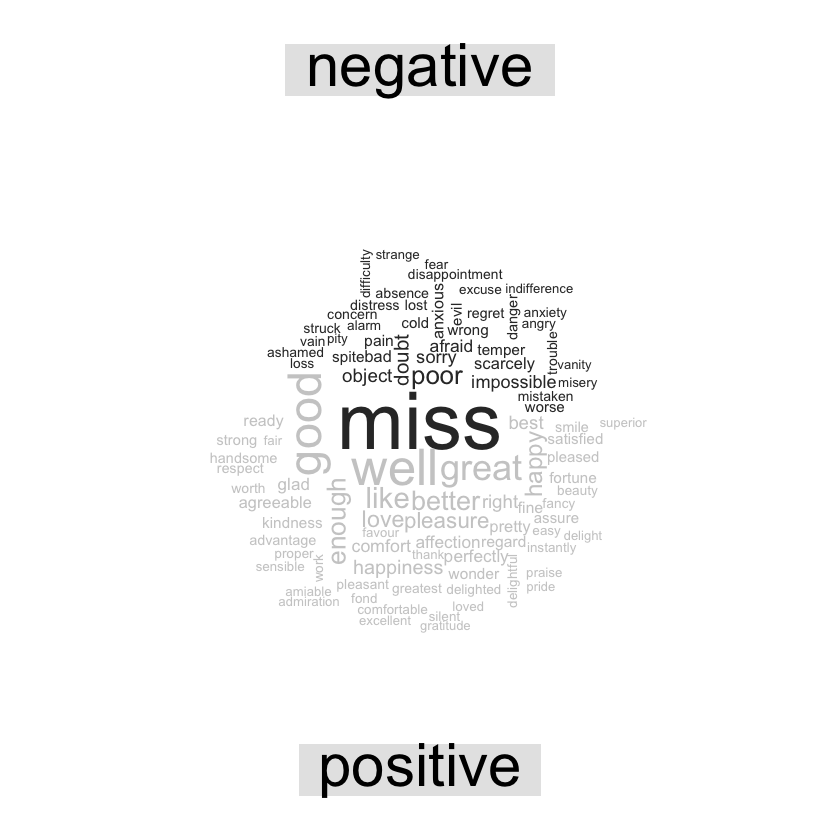
The size of each word corresponds to its frequency within its assigned sentiment group. This allows us to easily identify the most prominent positive and negative words. However, keep in mind that word sizes are scaled separately within each sentiment, so the sizes are not directly comparable across positive and negative categories.
Looking Beyond just Words#
While much useful analysis can be done by tokenizing text at the word level, there are situations where other units of text are more appropriate. For example, some sentiment analysis algorithms go beyond unigrams (single words) to assess the sentiment of an entire sentence. These methods can account for context, such as negation, recognizing that:
I am not having a good day.
is a negative sentence, despite containing words like good. R packages like coreNLP (T. Arnold and Tilton 2016), cleanNLP (T. B. Arnold 2016), and sentimentr (Rinker 2017) handle this type of sentiment analysis. In these cases, it’s common to tokenize by sentence and use a different output column name to reflect the change in text unit.
p_and_p_sentences <- tibble(text = prideprejudice) %>%
unnest_tokens(sentence, text, token = "sentences")
Let’s look at just one.
p_and_p_sentences$sentence[2]
Sentence tokenizing can sometimes struggle with UTF-8 encoded text, especially in sections of dialogue, but tends to perform better with ASCII punctuation. If this causes issues, one solution is to use iconv() to convert the text encoding, for example with iconv(text, to = 'latin1') inside a mutate statement before unnesting.
Another option with unnest_tokens() is to split the text into tokens using a regular expression. For instance, we could use this approach to break Jane Austen’s novels into a data frame by chapter based on a chapter header pattern.
austen_chapters <- austen_books() %>%
group_by(book) %>%
unnest_tokens(chapter, text, token = "regex",
pattern = "Chapter|CHAPTER [\\dIVXLC]") %>%
ungroup()
austen_chapters %>%
group_by(book) %>%
summarise(chapters = n()) %>%
print()
# A tibble: 6 x 2
book chapters
<fct> <int>
1 Sense & Sensibility 51
2 Pride & Prejudice 62
3 Mansfield Park 49
4 Emma 56
5 Northanger Abbey 32
6 Persuasion 25
We’ve successfully recovered the correct number of chapters for each novel (with one extra row for each title), and in the austen_chapters data frame, each row now represents a chapter.
Earlier, we used a similar regex pattern to locate chapter breaks when tokenizing text into one-word-per-row format. Now, using this tidy structure, we can explore questions like: Which chapters in Jane Austen’s novels are the most negative?
To answer this, we start by retrieving the list of negative words from the bing lexicon. Then, we create a data frame that counts the total number of words per chapter—this helps us normalize for chapter length. Next, we count how many negative words appear in each chapter and divide that by the total number of words in that chapter. Finally, we identify which chapter in each book has the highest proportion of negative words.
bingnegative <- get_sentiments("bing") %>%
filter(sentiment == "negative")
wordcounts <- tidy_books %>%
group_by(book, chapter) %>%
summarize(words = n())
tidy_books %>%
semi_join(bingnegative) %>%
group_by(book, chapter) %>%
summarize(negativewords = n()) %>%
left_join(wordcounts, by = c("book", "chapter")) %>%
mutate(ratio = negativewords/words) %>%
filter(chapter != 0) %>%
slice_max(ratio, n = 1) %>%
ungroup() %>%
print()
`summarise()` has grouped output by 'book'. You can override using the
`.groups` argument.
Joining with `by = join_by(word)`
`summarise()` has grouped output by 'book'. You can override using the
`.groups` argument.
# A tibble: 6 x 5
book chapter negativewords words ratio
<fct> <int> <int> <int> <dbl>
1 Sense & Sensibility 43 161 3405 0.0473
2 Pride & Prejudice 34 111 2104 0.0528
3 Mansfield Park 46 173 3685 0.0469
4 Emma 15 151 3340 0.0452
5 Northanger Abbey 21 149 2982 0.0500
6 Persuasion 4 62 1807 0.0343
The chapters with the highest proportion of negative words correspond to some of the most emotionally intense moments in each novel. For example, in Chapter 43 of Sense and Sensibility, Marianne is gravely ill and near death, while Chapter 34 of Pride and Prejudice features Mr. Darcy’s awkward first marriage proposal. Chapter 46 of Mansfield Park reveals Henry’s scandalous adultery near the story’s end, and in Chapter 15 of Emma, the unsettling Mr. Elton makes a proposal. In Chapter 21 of Northanger Abbey, Catherine is deeply caught up in her Gothic-inspired fantasies of murder, and Chapter 4 of Persuasion presents Anne’s painful flashback of refusing Captain Wentworth and her regret over that decision. These peaks in negative sentiment align closely with pivotal and often sorrowful moments in Austen’s narratives.
Analyzing Word and Document Frequency#
A key question in text mining and natural language processing is how to quantify what a document is about by examining its words. One simple measure is term frequency (tf), which counts how often a word appears in a document. However, some frequently occurring words like “the,” “is,” and “of” may not carry much meaningful information. While removing such stop words is common, this approach can be overly simplistic, since these words might be important in certain contexts.
A more nuanced method involves inverse document frequency (idf), which downweights words that appear in many documents and upweights rarer terms. Combining tf and idf gives us tf-idf a measure of how important a word is to a specific document within a larger collection. Although tf-idf is a heuristic rather than a theoretically rigorous measure, it has proven very useful in text mining and search engines.
Mathematically, idf for a term is defined as the natural logarithm of the total number of documents divided by the number of documents containing that term. Using tidy data principles, as introduced in Chapter 1, we can efficiently calculate and analyze tf-idf scores to identify key terms that define individual documents within a corpus.
Term Frequency in Jane Austen’s Novels#
Let’s begin by exploring Jane Austen’s published novels to analyze term frequency and then tf-idf. Using dplyr functions like group_by() and join(), we can identify the most commonly used words across her works. At the same time, we’ll calculate the total number of words in each novel, which will be useful later when we compute tf-idf scores. This approach helps us understand word importance both within individual novels and across the entire collection.
library(dplyr)
library(janeaustenr)
library(tidytext)
book_words <- austen_books() %>%
unnest_tokens(word, text) %>%
count(book, word, sort = TRUE)
total_words <- book_words %>%
group_by(book) %>%
summarize(total = sum(n))
book_words <- left_join(book_words, total_words)
print(book_words)
Joining with `by = join_by(book)`
# A tibble: 40,378 x 4
book word n total
<fct> <chr> <int> <int>
1 Mansfield Park the 6206 160465
2 Mansfield Park to 5475 160465
3 Mansfield Park and 5438 160465
4 Emma to 5239 160996
5 Emma the 5201 160996
6 Emma and 4896 160996
7 Mansfield Park of 4778 160465
8 Pride & Prejudice the 4331 122204
9 Emma of 4291 160996
10 Pride & Prejudice to 4162 122204
# i 40,368 more rows
The book_words data frame has one row for each word–book pair; the column n shows how many times that word appears in the book, and total is the total number of words in that book. Unsurprisingly, the most frequent words include common ones like “the,” “and,” and “to.”
We can visualize the distribution of n/total for each novel—this ratio represents the term frequency, showing how often a word occurs relative to the total words in that novel.
These plots have long right tails—representing those very common words—which aren’t fully displayed here. Overall, the distributions are similar across all the novels, showing many words that appear infrequently and only a few that occur very frequently.
library(ggplot2)
ggplot(book_words, aes(n/total, fill = book)) +
geom_histogram(show.legend = FALSE) +
xlim(NA, 0.0009) +
facet_wrap(~book, ncol = 2, scales = "free_y")
Zipf’s Law#
Distributions like those above are typical in natural language. In fact, these long-tailed patterns are so common in any text corpus—whether a book, website content, or spoken language—that the relationship between a word’s frequency and its rank has been extensively studied. This relationship is famously described by Zipf’s law, named after George Zipf, a 20th-century American linguist.
Zipf’s law states that a word’s frequency is roughly inversely proportional to its rank in the frequency list. Since we already have the data frame used to plot term frequencies, we can easily explore Zipf’s law for Jane Austen’s novels using just a few lines of dplyr code.
freq_by_rank <- book_words %>%
group_by(book) %>%
mutate(rank = row_number(),
term_frequency = n/total) %>%
ungroup()
print(freq_by_rank)
# A tibble: 40,378 x 6
book word n total rank term_frequency
<fct> <chr> <int> <int> <int> <dbl>
1 Mansfield Park the 6206 160465 1 0.0387
2 Mansfield Park to 5475 160465 2 0.0341
3 Mansfield Park and 5438 160465 3 0.0339
4 Emma to 5239 160996 1 0.0325
5 Emma the 5201 160996 2 0.0323
6 Emma and 4896 160996 3 0.0304
7 Mansfield Park of 4778 160465 4 0.0298
8 Pride & Prejudice the 4331 122204 1 0.0354
9 Emma of 4291 160996 4 0.0267
10 Pride & Prejudice to 4162 122204 2 0.0341
# i 40,368 more rows
The rank column assigns each word its position in the frequency table, which is ordered by n (the count), and we can use row_number() to generate these ranks. After that, we calculate the term frequency just as before. Zipf’s law is typically visualized by plotting rank on the x-axis and term frequency on the y-axis, both using logarithmic scales. When plotted this way, the inverse relationship predicted by Zipf’s law appears as a straight line with a constant negative slope.
freq_by_rank %>%
ggplot(aes(rank, term_frequency, color = book)) +
geom_line(linewidth = 1.1, alpha = 0.8, show.legend = FALSE) +
scale_x_log10() +
scale_y_log10()
The graph is plotted using log-log coordinates, showing that all six of Jane Austen’s novels follow similar patterns where the relationship between rank and frequency has a clear negative slope. However, this slope isn’t perfectly constant—suggesting the distribution might be better described as a broken power law divided into, say, three sections. To explore this further, let’s focus on the middle section of the rank range and calculate the exponent of the power law there.
rank_subset <- freq_by_rank %>%
filter(rank < 500,
rank > 10)
lm(log10(term_frequency) ~ log10(rank), data = rank_subset)
Call:
lm(formula = log10(term_frequency) ~ log10(rank), data = rank_subset)
Coefficients:
(Intercept) log10(rank)
-0.6226 -1.1125
Classic Zipf’s law states that frequency is proportional to 1 divided by rank, which corresponds to a slope of about -1 on a log-log plot. Since our calculated slope is close to -1, let’s plot this fitted power law alongside the data from above to visually compare how well it matches.
freq_by_rank %>%
ggplot(aes(rank, term_frequency, color = book)) +
geom_abline(intercept = -0.62, slope = -1.1,
color = "gray50", linetype = 2) +
geom_line(linewidth = 1.1, alpha = 0.8, show.legend = FALSE) +
scale_x_log10() +
scale_y_log10()
Our analysis of Jane Austen’s novels reveals a result close to the classic Zipf’s law. The deviations at high ranks—where fewer rare words appear than a single power law would predict—are typical in many language corpora. However, the deviations at low ranks are more unusual: Austen uses a smaller proportion of the very most common words compared to many other text collections. This type of analysis can be easily extended to compare different authors or other text collections, all while leveraging the simplicity and power of tidy data principles.
The bind_tf_idf() Function#
The idea behind tf-idf is to identify the most important words in each document by reducing the weight of very common words and increasing the weight of words that are relatively rare across the whole collection—in this case, Jane Austen’s novels as a group. Calculating tf-idf helps highlight words that are frequent within a specific text but not overused across the entire corpus.
To do this, we use the bind_tf_idf() function from the tidytext package, which takes a tidy text dataset as input. The dataset should have one row per token (word) per document. It needs a column with the terms (like word), a column identifying the documents (like book), and a column with the counts of each term in each document (n). Although we previously calculated totals for each book, bind_tf_idf() doesn’t require those—just the complete list of words and their counts for each document.
book_tf_idf <- book_words %>%
bind_tf_idf(word, book, n)
print(book_tf_idf)
# A tibble: 40,378 x 7
book word n total tf idf tf_idf
<fct> <chr> <int> <int> <dbl> <dbl> <dbl>
1 Mansfield Park the 6206 160465 0.0387 0 0
2 Mansfield Park to 5475 160465 0.0341 0 0
3 Mansfield Park and 5438 160465 0.0339 0 0
4 Emma to 5239 160996 0.0325 0 0
5 Emma the 5201 160996 0.0323 0 0
6 Emma and 4896 160996 0.0304 0 0
7 Mansfield Park of 4778 160465 0.0298 0 0
8 Pride & Prejudice the 4331 122204 0.0354 0 0
9 Emma of 4291 160996 0.0267 0 0
10 Pride & Prejudice to 4162 122204 0.0341 0 0
# i 40,368 more rows
Notice that the inverse document frequency (idf), and therefore tf-idf, is zero for extremely common words that appear in all six of Jane Austen’s novels. This happens because the idf is calculated as the natural logarithm of the total number of documents divided by the number of documents containing the word—so when a word appears in every document, that ratio is 1, and log(1) equals zero. As a result, common words get very low or zero tf-idf scores, which reduces their importance in the analysis.
In contrast, words that appear in fewer documents have higher idf values, boosting their tf-idf scores and highlighting their uniqueness to particular texts. Let’s now explore which terms have the highest tf-idf values in Jane Austen’s works.
book_tf_idf %>%
select(-total) %>%
arrange(desc(tf_idf)) %>%
print()
# A tibble: 40,378 x 6
book word n tf idf tf_idf
<fct> <chr> <int> <dbl> <dbl> <dbl>
1 Sense & Sensibility elinor 623 0.00519 1.79 0.00931
2 Sense & Sensibility marianne 492 0.00410 1.79 0.00735
3 Mansfield Park crawford 493 0.00307 1.79 0.00550
4 Pride & Prejudice darcy 373 0.00305 1.79 0.00547
5 Persuasion elliot 254 0.00304 1.79 0.00544
6 Emma emma 786 0.00488 1.10 0.00536
7 Northanger Abbey tilney 196 0.00252 1.79 0.00452
8 Emma weston 389 0.00242 1.79 0.00433
9 Pride & Prejudice bennet 294 0.00241 1.79 0.00431
10 Persuasion wentworth 191 0.00228 1.79 0.00409
# i 40,368 more rows
Here, we observe mostly proper nouns—names that are indeed significant in these novels. Since none of these names appear in all six novels, they receive higher tf-idf scores, making them distinctive and characteristic terms for each individual book within Jane Austen’s corpus.
Some idf values repeat because the corpus has six documents, so the values correspond to the natural logarithms of ratios like ln(6/1), ln(6/2), and so on.
Next, let’s visualize these high tf-idf words to better understand their importance across the novels.
library(forcats)
book_tf_idf %>%
group_by(book) %>%
slice_max(tf_idf, n = 15) %>%
ungroup() %>%
ggplot(aes(tf_idf, fct_reorder(word, tf_idf), fill = book)) +
geom_col(show.legend = FALSE) +
facet_wrap(~book, ncol = 2, scales = "free") +
labs(x = "tf-idf", y = NULL)
These still highlight mainly proper nouns! These words, identified by their high tf-idf scores, are the most important and distinctive terms for each novel—something most readers would agree with. What tf-idf reveals here is that Jane Austen’s language is quite consistent across her six novels, and the key differences that set each novel apart are the proper nouns—the names of characters and places. This perfectly illustrates the purpose of tf-idf: to pinpoint words that are especially significant to individual documents within a larger collection.
A Corpus of Physics Texts#
Let’s explore a different set of documents to see which terms stand out as important. Stepping away from fiction and narrative, we’ll download several classic physics texts from Project Gutenberg: Discourse on Floating Bodies by Galileo Galilei, Treatise on Light by Christiaan Huygens, Experiments with Alternate Currents of High Potential and High Frequency by Nikola Tesla, and Relativity: The Special and General Theory by Albert Einstein.
This collection is quite diverse—these physics classics span over 300 years, and some were originally written in other languages before being translated into English. While not perfectly uniform, this variety makes for a fascinating analysis of important terms using tf-idf.
library(gutenbergr)
physics <- gutenberg_download(c(37729, 14725, 13476, 30155),
meta_fields = "author")
Now that we have the texts, let’s use unnest_tokens() and count() to find out how many times each word was used in each text.
physics_words <- physics %>%
unnest_tokens(word, text) %>%
count(author, word, sort = TRUE)
print(physics_words)
# A tibble: 12,664 x 3
author word n
<chr> <chr> <int>
1 Galilei, Galileo the 3760
2 Tesla, Nikola the 3604
3 Huygens, Christiaan the 3553
4 Einstein, Albert the 2993
5 Galilei, Galileo of 2049
6 Einstein, Albert of 2029
7 Tesla, Nikola of 1737
8 Huygens, Christiaan of 1708
9 Huygens, Christiaan to 1207
10 Tesla, Nikola a 1177
# i 12,654 more rows
Here we are looking at just the raw word counts, but it’s important to keep in mind that these documents vary greatly in length. To better understand which terms are truly important relative to the size of each text, we calculate the tf-idf scores. This adjusts for document length and highlights distinctive words in each text. After calculating tf-idf, we can visualize the words with the highest tf-idf values to see which terms stand out most in each physics classic.
plot_physics <- physics_words %>%
bind_tf_idf(word, author, n) %>%
mutate(author = factor(author, levels = c("Galilei, Galileo",
"Huygens, Christiaan",
"Tesla, Nikola",
"Einstein, Albert")))
plot_physics %>%
group_by(author) %>%
slice_max(tf_idf, n = 15) %>%
ungroup() %>%
mutate(word = reorder(word, tf_idf)) %>%
ggplot(aes(tf_idf, word, fill = author)) +
geom_col(show.legend = FALSE) +
labs(x = "tf-idf", y = NULL) +
facet_wrap(~author, ncol = 2, scales = "free")
Yeah, that definitely catches the eye! The letter “k” showing up with a high tf-idf score in Einstein’s text probably means it’s a key technical term or variable used frequently in Relativity: The Special and General Theory but not much elsewhere. In physics and math, single letters like “k” often represent constants, coefficients, or variables, so it makes sense it would stand out compared to other documents. It’s a neat example of how tf-idf highlights terms that are uniquely important to a specific document! Want to dig into what “k” represents in Einstein’s work?
library(stringr)
physics %>%
filter(str_detect(text, "_k_")) %>%
select(text) %>%
print()
# A tibble: 7 x 1
text
<chr>
1 "surface AB at the points AK_k_B. Then instead of the hemispherical"
2 "would needs be that from all the other points K_k_B there should"
3 "necessarily be equal to CD, because C_k_ is equal to CK, and C_g_ to"
4 "the crystal at K_k_, all the points of the wave CO_oc_ will have"
5 "O_o_ has reached K_k_. Which is easy to comprehend, since, of these"
6 "CO_oc_ in the crystal, when O_o_ has arrived at K_k_, because it forms"
7 "\u03c1 is the average density of the matter and _k_ is a constant connected"
Some text cleaning may be necessary. Also, notice that “co” and “ordinate” appear separately among the high tf-idf words for Einstein’s text; this happens because `unnest_tokens() by default splits on punctuation such as hyphens. The tf-idf values for “co” and “ordinate” are nearly identical!
Additionally, abbreviations like “AB” and “RC” refer to names of rays, circles, angles, and similar concepts in Huygens’ work.
physics %>%
filter(str_detect(text, "RC")) %>%
select(text) %>%
print()
# A tibble: 44 x 1
text
<chr>
1 line RC, parallel and equal to AB, to be a portion of a wave of light,
2 represents the partial wave coming from the point A, after the wave RC
3 be the propagation of the wave RC which fell on AB, and would be the
4 transparent body; seeing that the wave RC, having come to the aperture
5 incident rays. Let there be such a ray RC falling upon the surface
6 CK. Make CO perpendicular to RC, and across the angle KCO adjust OK,
7 the required refraction of the ray RC. The demonstration of this is,
8 explaining ordinary refraction. For the refraction of the ray RC is
9 29. Now as we have found CI the refraction of the ray RC, similarly
10 the ray _r_C is inclined equally with RC, the line C_d_ will
# i 34 more rows
To create a clearer and more meaningful plot, let’s remove some of these less relevant words. We do this by creating a custom list of stop words and applying anti_join() to filter them out. This method is flexible and can be adapted to various situations. Since we’re removing words from the tidy data frame, we’ll need to revisit some earlier steps in the process.
mystopwords <- tibble(word = c("eq", "co", "rc", "ac", "ak", "bn",
"fig", "file", "cg", "cb", "cm",
"ab", "_k", "_k_", "_x"))
physics_words <- anti_join(physics_words, mystopwords,
by = "word")
plot_physics <- physics_words %>%
bind_tf_idf(word, author, n) %>%
mutate(word = str_remove_all(word, "_")) %>%
group_by(author) %>%
slice_max(tf_idf, n = 15) %>%
ungroup() %>%
mutate(word = fct_reorder(word, tf_idf)) %>%
mutate(author = factor(author, levels = c("Galilei, Galileo",
"Huygens, Christiaan",
"Tesla, Nikola",
"Einstein, Albert")))
ggplot(plot_physics, aes(tf_idf, word, fill = author)) +
geom_col(show.legend = FALSE) +
facet_wrap(~author, ncol = 2, scales = "free") +
labs(x = "tf-idf", y = NULL)
One takeaway from this is that modern physics discussions rarely mention ramparts or describe things as ethereal.
The examples from Jane Austen and physics in this chapter showed little overlap in high tf-idf words across different categories like books or authors. However, if you do encounter shared high tf-idf words across categories, you might consider using reorder_within() and scale_*_reordered() to create clearer visualizations.
Relationships Between Words#
Up to this point, we’ve treated words as individual units and explored how they relate to sentiments or documents. However, much of text analysis focuses on the relationships between words — such as which words tend to appear next to one another or co-occur within the same text.
In this chapter, we’ll look at tidytext methods for calculating and visualizing word relationships within the dataset. This includes using token = "ngrams" to break text into pairs of adjacent words instead of single words. We’ll also introduce two helpful packages: ggraph, which builds network plots based on ggplot2, and widyr, which calculates pairwise correlations and distances in tidy data frames. These tools expand how we can explore text data within the tidy framework.
Tokenizing by n-gram#
So far, we’ve used unnest_tokens() to break text into individual words or sentences, which works well for sentiment and frequency analysis. However, we can also use this function to create sequences of consecutive words, known as n-grams. By analyzing how often one word follows another, we can better understand the relationships between words.
To do this, we simply add token = "ngrams" to unnest_tokens() and set n to the number of consecutive words we want to group. When n = 2, we generate pairs of consecutive words, commonly referred to as bigrams.
library(dplyr)
library(tidytext)
library(janeaustenr)
austen_bigrams <- austen_books() %>%
unnest_tokens(bigram, text, token = "ngrams", n = 2) %>%
filter(!is.na(bigram))
print(austen_bigrams)
# A tibble: 662,792 x 2
book bigram
<fct> <chr>
1 Sense & Sensibility sense and
2 Sense & Sensibility and sensibility
3 Sense & Sensibility by jane
4 Sense & Sensibility jane austen
5 Sense & Sensibility chapter 1
6 Sense & Sensibility the family
7 Sense & Sensibility family of
8 Sense & Sensibility of dashwood
9 Sense & Sensibility dashwood had
10 Sense & Sensibility had long
# i 662,782 more rows
This structure remains consistent with the tidy text format, where each row represents one token, but in this case, the tokens are bigrams rather than individual words. Additional information, like the book name, is still included.
It’s important to note that these bigrams overlap — for example, “sense and” is one token, and “and sensibility” is the next.
Counting and Filtering n-grams#
The same tidy tools we’ve been using for single words work just as well for n-gram analysis. We can use functions like count() from dplyr to easily find the most common bigrams in the text.
austen_bigrams %>%
count(bigram, sort = TRUE) %>%
print()
# A tibble: 193,212 x 2
bigram n
<chr> <int>
1 of the 2853
2 to be 2670
3 in the 2221
4 it was 1691
5 i am 1485
6 she had 1405
7 of her 1363
8 to the 1315
9 she was 1309
10 had been 1206
# i 193,202 more rows
As expected, many of the most frequent bigrams consist of common, uninformative words like “of the” or “to be,” which are considered stop words. To clean this up, we can use separate() from tidyr to split the bigrams into two columns—word1 and word2—allowing us to filter out any bigrams where either word is a stop word.
library(tidyr)
bigrams_separated <- austen_bigrams %>%
separate(bigram, c("word1", "word2"), sep = " ")
bigrams_filtered <- bigrams_separated %>%
filter(!word1 %in% stop_words$word) %>%
filter(!word2 %in% stop_words$word)
# new bigram counts:
bigram_counts <- bigrams_filtered %>%
count(word1, word2, sort = TRUE)
print(bigram_counts)
# A tibble: 28,971 x 3
word1 word2 n
<chr> <chr> <int>
1 sir thomas 266
2 miss crawford 196
3 captain wentworth 143
4 miss woodhouse 143
5 frank churchill 114
6 lady russell 110
7 sir walter 108
8 lady bertram 101
9 miss fairfax 98
10 colonel brandon 96
# i 28,961 more rows
We notice that many of the most frequent bigrams in Jane Austen’s novels are names, either full names or names paired with titles like “Mr.” or “Miss.”
In some cases, though, we might want to work with the bigrams as single, recombined units again. For that, we can use unite() from tidyr, which reverses the effect of separate() and merges multiple columns back into one. Using a combination of separate(), filtering out stop words, count(), and then unite(), we can easily identify the most frequent meaningful bigrams that exclude common stop words.
bigrams_united <- bigrams_filtered %>%
unite(bigram, word1, word2, sep = " ")
print(bigrams_united)
# A tibble: 38,910 x 2
book bigram
<fct> <chr>
1 Sense & Sensibility jane austen
2 Sense & Sensibility chapter 1
3 Sense & Sensibility norland park
4 Sense & Sensibility surrounding acquaintance
5 Sense & Sensibility late owner
6 Sense & Sensibility advanced age
7 Sense & Sensibility constant companion
8 Sense & Sensibility happened ten
9 Sense & Sensibility henry dashwood
10 Sense & Sensibility norland estate
# i 38,900 more rows
For other types of analysis, you might want to focus on trigrams—sequences of three consecutive words. To extract those, you simply set n = 3 when using unnest_tokens() with token = "ngrams".
austen_books() %>%
unnest_tokens(trigram, text, token = "ngrams", n = 3) %>%
filter(!is.na(trigram)) %>%
separate(trigram, c("word1", "word2", "word3"), sep = " ") %>%
filter(!word1 %in% stop_words$word,
!word2 %in% stop_words$word,
!word3 %in% stop_words$word) %>%
count(word1, word2, word3, sort = TRUE) %>%
print()
# A tibble: 6,139 x 4
word1 word2 word3 n
<chr> <chr> <chr> <int>
1 dear miss woodhouse 20
2 miss de bourgh 17
3 lady catherine de 11
4 poor miss taylor 11
5 sir walter elliot 10
6 catherine de bourgh 9
7 dear sir thomas 8
8 replied miss crawford 7
9 sir william lucas 7
10 ten thousand pounds 7
# i 6,129 more rows
Analyzing bigrams#
Having one bigram per row makes exploratory text analysis straightforward. For instance, we can easily investigate the most frequently mentioned “streets” in each book by filtering bigrams for those where the second word is “street” and summarizing the results.
bigrams_filtered %>%
filter(word2 == "street") %>%
count(book, word1, sort = TRUE) %>%
print()
# A tibble: 33 x 3
book word1 n
<fct> <chr> <int>
1 Sense & Sensibility harley 16
2 Sense & Sensibility berkeley 15
3 Northanger Abbey milsom 10
4 Northanger Abbey pulteney 10
5 Mansfield Park wimpole 9
6 Pride & Prejudice gracechurch 8
7 Persuasion milsom 5
8 Sense & Sensibility bond 4
9 Sense & Sensibility conduit 4
10 Persuasion rivers 4
# i 23 more rows
We can also treat bigrams as terms within documents, similar to how we handled single words. For instance, we can calculate the tf-idf values for bigrams across Jane Austen’s novels. These tf-idf scores highlight which word pairs are most characteristic of each book, and we can visualize them in the same way we previously visualized single-word tf-idf values.
bigram_tf_idf <- bigrams_united %>%
count(book, bigram) %>%
bind_tf_idf(bigram, book, n) %>%
arrange(desc(tf_idf))
print(bigram_tf_idf)
# A tibble: 31,388 x 6
book bigram n tf idf tf_idf
<fct> <chr> <int> <dbl> <dbl> <dbl>
1 Mansfield Park sir thomas 266 0.0304 1.79 0.0546
2 Persuasion captain wentworth 143 0.0290 1.79 0.0519
3 Mansfield Park miss crawford 196 0.0224 1.79 0.0402
4 Persuasion lady russell 110 0.0223 1.79 0.0399
5 Persuasion sir walter 108 0.0219 1.79 0.0392
6 Emma miss woodhouse 143 0.0173 1.79 0.0309
7 Northanger Abbey miss tilney 74 0.0165 1.79 0.0295
8 Sense & Sensibility colonel brandon 96 0.0155 1.79 0.0278
9 Sense & Sensibility sir john 94 0.0152 1.79 0.0273
10 Pride & Prejudice lady catherine 87 0.0139 1.79 0.0248
# i 31,378 more rows
bigram_tf_idf %>%
group_by(book) %>%
slice_max(tf_idf, n = 10) %>%
ungroup() %>%
ggplot(aes(tf_idf, fct_reorder(bigram, tf_idf), fill = book)) +
geom_col(show.legend = FALSE) +
facet_wrap(~book, ncol = 2, scales = "free") +
labs(x = "tf-idf", y = NULL)
Just like we saw in Chapter 3, the bigrams that distinguish each Austen novel are mostly names. We also notice some verb-name pairs, like “replied elinor” in Sense & Sensibility or “cried catherine” in Northanger Abbey.
Analyzing tf-idf for bigrams has its pros and cons. On the plus side, pairs of consecutive words can capture context and structure that single words miss—“maple grove” in Emma, for example, is more meaningful than just “maple.” On the downside, bigrams tend to be much rarer than individual words, so their counts are sparser. Because of this, bigrams are especially helpful when working with very large text datasets.
Using Bigrams to Provide Context#
Our sentiment analysis method from above counted positive or negative words based on a reference lexicon. However, one issue with this approach is that context can be just as important as the word itself. For instance, words like “happy” and “like” would register as positive even in sentences like “I’m not happy and I don’t like it!”
With our data now structured as bigrams, it becomes straightforward to see how often words are preceded by negations like “not”:
bigrams_separated %>%
filter(word1 == "not") %>%
count(word1, word2, sort = TRUE) %>%
print()
# A tibble: 1,178 x 3
word1 word2 n
<chr> <chr> <int>
1 not be 580
2 not to 335
3 not have 307
4 not know 237
5 not a 184
6 not think 162
7 not been 151
8 not the 135
9 not at 126
10 not in 110
# i 1,168 more rows
By conducting sentiment analysis on the bigram data, we can identify how frequently sentiment-bearing words are preceded by negations like “not.” This allows us to either exclude or invert their sentiment contribution accordingly.
Let’s apply the AFINN lexicon for this analysis, which assigns numeric sentiment scores to words—positive values for positive sentiment and negative values for negative sentiment.
AFINN <- get_sentiments("afinn")
print(AFINN)
# A tibble: 2,477 x 2
word value
<chr> <dbl>
1 abandon -2
2 abandoned -2
3 abandons -2
4 abducted -2
5 abduction -2
6 abductions -2
7 abhor -3
8 abhorred -3
9 abhorrent -3
10 abhors -3
# i 2,467 more rows
Next, we can look at which sentiment-associated words most often appear right after “not.” This helps us understand how negation affects the sentiment of those words by identifying the most frequent such bigrams.
not_words <- bigrams_separated %>%
filter(word1 == "not") %>%
inner_join(AFINN, by = c(word2 = "word")) %>%
count(word2, value, sort = TRUE)
print(not_words)
# A tibble: 229 x 3
word2 value n
<chr> <dbl> <int>
1 like 2 95
2 help 2 77
3 want 1 41
4 wish 1 39
5 allow 1 30
6 care 2 21
7 sorry -1 20
8 leave -1 17
9 pretend -1 17
10 worth 2 17
# i 219 more rows
For instance, the word most frequently following “not” with an associated sentiment was “like,” which typically carries a positive score of 2.
It’s also insightful to identify which words contributed most to sentiment in the “wrong” direction due to negation. We calculate this by multiplying each word’s sentiment value by its frequency — so a word with a sentiment score of +3 appearing 10 times has the same impact as a word with a score of +1 appearing 30 times. We then visualize these results in a bar plot.
library(ggplot2)
mutate(contribution = n * value) %>%
arrange(desc(abs(contribution))) %>%
head(20) %>%
mutate(word2 = reorder(word2, contribution)) %>%
ggplot(aes(n * value, word2, fill = n * value > 0)) +
geom_col(show.legend = FALSE) +
labs(x = "Sentiment value * number of occurrences",
y = "Words preceded by \"not\"")
The bigrams “not like” and “not help” were by far the biggest contributors to misclassification, causing the text to appear more positive than it actually is. However, phrases such as “not afraid” and “not fail” sometimes make the text seem more negative than intended.
“Not” isn’t the only word that modifies the sentiment of the following term. We could select four or more common negation words and apply the same join-and-count method to analyze all of them together.
negation_words <- c("not", "no", "never", "without")
negated_words <- bigrams_separated %>%
filter(word1 %in% negation_words) %>%
inner_join(AFINN, by = c(word2 = "word")) %>%
count(word1, word2, value, sort = TRUE)
We can then create a visualization showing the most frequent words that follow each specific negation word. While “not like” and “not help” remain the top examples, we also observe pairs like “no great” and “never loved.” Combining this with the methods from before, we could invert the AFINN sentiment scores for words that come after negations. This demonstrates just a few ways that analyzing consecutive words adds valuable context to text mining techniques.
negated_words %>%
mutate(contribution = n * value,
word2 = reorder(paste(word2, word1, sep = "__"), contribution)) %>%
group_by(word1) %>%
slice_max(abs(contribution), n = 12, with_ties = FALSE) %>%
ggplot(aes(word2, contribution, fill = n * value > 0)) +
geom_col(show.legend = FALSE) +
facet_wrap(~ word1, scales = "free") +
scale_x_discrete(labels = function(x) gsub("__.+$", "", x)) +
xlab("Words preceded by negation term") +
ylab("Sentiment value * # of occurrences") +
coord_flip()
Visualizing a Network of Bigrams with ggraph#
We might want to visualize all the relationships between words at once, not just a few top pairs. A common way to do this is by creating a network—or “graph”—where words are nodes connected by edges.
Here, “graph” means a structure made of connected nodes, not just a plot. A graph can be built from tidy data that contains three key variables:
from: the starting node of an edge
to: the ending node of an edge
weight: a numeric value associated with the edge (like frequency)
The igraph package provides many tools for handling and analyzing such networks. To create an igraph object from tidy data, we use the graph_from_data_frame() function, which takes a data frame of edges with columns for “from”, “to”, and any edge attributes (such as counts n in this case).
library(igraph)
# original counts
print(bigram_counts)
# filter for only relatively common combinations
bigram_graph <- bigram_counts %>%
filter(n > 20) %>%
graph_from_data_frame()
print(bigram_graph)
# A tibble: 28,971 x 3
word1 word2 n
<chr> <chr> <int>
1 sir thomas 266
2 miss crawford 196
3 captain wentworth 143
4 miss woodhouse 143
5 frank churchill 114
6 lady russell 110
7 sir walter 108
8 lady bertram 101
9 miss fairfax 98
10 colonel brandon 96
# i 28,961 more rows
IGRAPH b3d14c8 DN-- 85 70 --
+ attr: name (v/c), n (e/n)
+ edges from b3d14c8 (vertex names):
[1] sir ->thomas miss ->crawford captain ->wentworth
[4] miss ->woodhouse frank ->churchill lady ->russell
[7] sir ->walter lady ->bertram miss ->fairfax
[10] colonel ->brandon sir ->john miss ->bates
[13] jane ->fairfax lady ->catherine lady ->middleton
[16] miss ->tilney miss ->bingley thousand->pounds
[19] miss ->dashwood dear ->miss miss ->bennet
[22] miss ->morland captain ->benwick miss ->smith
+ ... omitted several edges
While igraph includes some plotting functions, they aren’t its main focus, so many other packages have created better visualization tools for graph objects. We recommend the ggraph package (Pedersen 2017), which builds graph visualizations using the grammar of graphics—just like ggplot2, which you’re already familiar with.
With ggraph, you start by converting your igraph object using the ggraph() function. Then you add layers just like in ggplot2. For a basic network plot, you typically add three layers:
nodes (the points or vertices),
edges (the connections between nodes), and
text (labels on the nodes).
This approach makes graph visualization intuitive and flexible within the tidy data framework.
library(ggraph)
set.seed(2017)
ggraph(bigram_graph, layout = "fr") +
geom_edge_link() +
geom_node_point() +
geom_node_text(aes(label = name), vjust = 1, hjust = 1)
The above visualization reveals key aspects of the text’s structure. Salutations like “miss,” “lady,” “sir,” and “colonel” appear as central nodes, frequently connected to names that follow them. Around the edges, we notice common short phrases made up of pairs or triplets of words, such as “half hour,” “thousand pounds,” and “short time/pause.” This network view helps highlight how certain words cluster together in meaningful patterns within the text.
We can also refine the graph’s appearance to enhance readability:
The
edge\_alphaaesthetic is added to the links, making connections more transparent when bigrams are less frequent and more opaque when they’re common.Directionality is shown with arrows, created using
grid::arrow(), with anend\_capoption to ensure arrows stop just before the nodes for clarity.The nodes are styled to be more visually appealing—made larger and colored blue.
Finally, we apply
theme\_void()to remove background elements and axes, which is ideal for network visualizations.
set.seed(2020)
a <- grid::arrow(type = "closed", length = unit(.15, "inches"))
ggraph(bigram_graph, layout = "fr") +
geom_edge_link(aes(edge_alpha = n), show.legend = FALSE,
arrow = a, end_cap = circle(.07, 'inches')) +
geom_node_point(color = "lightblue", size = 5) +
geom_node_text(aes(label = name), vjust = 1, hjust = 1) +
theme_void()
Getting your networks to look polished with ggraph might take some trial and error, but this network structure offers a powerful and flexible way to visualize relationships in tidy data.
Keep in mind, this visualization represents a Markov chain, a common model in text analysis where each word depends only on the one before it. For example, a Markov chain-based text generator might start with “dear,” then move to “sir,” followed by “william,” “walter,” or “thomas,” by selecting the most frequent next word at each step.
To keep the graph readable, we only display the most common word-to-word links, but theoretically, you could build a massive graph showing every connection present in the text.
Visualizing Bigrams in Other Texts#
We put significant effort into cleaning and visualizing bigrams from a text dataset, so now let’s wrap that process into a function. This will allow us to easily apply the same bigram counting and visualization steps to other text datasets.
library(dplyr)
library(tidyr)
library(tidytext)
library(ggplot2)
library(igraph)
library(ggraph)
count_bigrams <- function(dataset) {
dataset %>%
unnest_tokens(bigram, text, token = "ngrams", n = 2) %>%
separate(bigram, c("word1", "word2"), sep = " ") %>%
filter(!word1 %in% stop_words$word,
!word2 %in% stop_words$word) %>%
count(word1, word2, sort = TRUE)
}
visualize_bigrams <- function(bigrams) {
set.seed(2016)
a <- grid::arrow(type = "closed", length = unit(.15, "inches"))
bigrams %>%
graph_from_data_frame() %>%
ggraph(layout = "fr") +
geom_edge_link(aes(edge_alpha = n), show.legend = FALSE, arrow = a) +
geom_node_point(color = "lightblue", size = 5) +
geom_node_text(aes(label = name), vjust = 1, hjust = 1) +
theme_void()
}
Now, we can apply our bigram visualization to other texts, like the King James Version of the Bible:
library(gutenbergr)
# the King James version is book 10 on Project Gutenberg:
kjv <- gutenberg_download(10)
library(stringr)
kjv_bigrams <- kjv %>%
count_bigrams()
# filter out rare combinations, as well as digits
kjv_bigrams %>%
filter(n > 40,
!str_detect(word1, "\\d"),
!str_detect(word2, "\\d")) %>%
visualize_bigrams()
This reveals a typical language pattern in the Bible, especially centered on “thy” and “thou” — words that might well be considered stopwords! Using the gutenbergr package alongside the count\_bigrams and visualize\_bigrams functions, you can explore and visualize bigrams in other classic texts that interest you.
Counting and Correlating Pairs of Words with the widyr Package#
Tokenizing by n-grams is a helpful approach for examining pairs of adjacent words, but we might also be curious about words that frequently appear together within a document or chapter, even if they aren’t positioned side by side.
While tidy data provides a convenient structure for grouping by rows or comparing variables, comparing between rows — such as counting how often two words appear within the same document or measuring how strongly they are correlated — can be more complex. Typically, to perform pairwise counts or calculate correlations, the data needs to be reshaped into a wide matrix format first.
We’ll explore specific ways to convert tidy text data into wide matrices later, but for this task, that step isn’t required. The widyr package simplifies these kinds of operations, allowing us to skip the manual process of widening, analyzing, and then returning to tidy format.
We’ll focus on widyr functions designed for pairwise comparisons — for example, comparing words across different documents or sections of text — making it easy to compute pairwise counts or correlations while keeping the workflow consistent with tidy principles.
Counting and Correlating Among Sections#
Let’s take the book Pride and Prejudice and divide it into sections of 10 lines, similar to how we grouped larger sections for sentiment analysis. This smaller chunk size allows us to analyze word patterns in more detail. Specifically, we can investigate which words frequently appear together within the same 10-line section, providing insight into word relationships beyond immediate adjacency.
austen_section_words <- austen_books() %>%
filter(book == "Pride & Prejudice") %>%
mutate(section = row_number() %/% 10) %>%
filter(section > 0) %>%
unnest_tokens(word, text) %>%
filter(!word %in% stop_words$word)
print(austen_section_words)
# A tibble: 37,240 x 3
book section word
<fct> <dbl> <chr>
1 Pride & Prejudice 1 truth
2 Pride & Prejudice 1 universally
3 Pride & Prejudice 1 acknowledged
4 Pride & Prejudice 1 single
5 Pride & Prejudice 1 possession
6 Pride & Prejudice 1 fortune
7 Pride & Prejudice 1 wife
8 Pride & Prejudice 1 feelings
9 Pride & Prejudice 1 views
10 Pride & Prejudice 1 entering
# i 37,230 more rows
The pairwise_count() function from the widyr package is particularly helpful for this kind of analysis. As the prefix pairwise\_ suggests, the result will include one row for each unique pair of words from the word variable. Using this, we can count how often pairs of words appear together within the same section of text — in this case, within the same 10-line section of Pride and Prejudice. This approach gives us insight into word co-occurrence patterns beyond adjacent word pairs like bigrams.
library(widyr)
# count words co-occuring within sections
word_pairs <- austen_section_words %>%
pairwise_count(word, section, sort = TRUE)
print(word_pairs)
# A tibble: 796,008 x 3
item1 item2 n
<chr> <chr> <dbl>
1 darcy elizabeth 144
2 elizabeth darcy 144
3 miss elizabeth 110
4 elizabeth miss 110
5 elizabeth jane 106
6 jane elizabeth 106
7 miss darcy 92
8 darcy miss 92
9 elizabeth bingley 91
10 bingley elizabeth 91
# i 795,998 more rows
Here, the input data originally had one row per word per 10-line section of Pride and Prejudice. After using pairwise_count(), the output reshapes into a tidy format where each row represents a unique pair of words and the number of times they co-occur within the same section.
This structure enables new kinds of analysis, such as determining which words most frequently appear alongside “Darcy.” Using simple filtering and sorting, we can quickly extract the top co-occurring words, revealing patterns of association within the text — for instance, showing that “Elizabeth” appears most often with “Darcy,” reflecting their central roles in the novel.
word_pairs %>%
filter(item1 == "darcy") %>%
print()
# A tibble: 2,930 x 3
item1 item2 n
<chr> <chr> <dbl>
1 darcy elizabeth 144
2 darcy miss 92
3 darcy bingley 86
4 darcy jane 46
5 darcy bennet 45
6 darcy sister 45
7 darcy time 41
8 darcy lady 38
9 darcy friend 37
10 darcy wickham 37
# i 2,920 more rows
Pairwise Correlation#
Pairs like “Elizabeth” and “Darcy” naturally co-occur frequently, but that alone isn’t very informative since both words are so common in the text individually. Instead of just counting, we can examine correlation, which captures how often two words appear together relative to how often they appear separately.
One way to measure this is the phi coefficient, a standard statistic for binary association. It reflects how much more likely it is that both words appear together (or both are absent) than one appears without the other.
The idea comes from a 2x2 contingency table:
Has word Y |
No word Y |
Total |
|
|---|---|---|---|
Has word X |
n₁₁ |
n₁₀ |
n₁• |
No word X |
n₀₁ |
n₀₀ |
n₀• |
Total |
n•₁ |
n•₀ |
n |
n₁₁ = sections with both word X and word Y
n₀₀ = sections with neither word
n₁₀, n₀₁ = sections where only one word appears
The phi coefficient is calculated as:
ϕ = (n₁₁ * n₀₀ - n₁₀ * n₀₁) / √(n₁• * n₀• * n•₀ * n•₁)
This measure is identical to the Pearson correlation when applied to binary (present/absent) data.
The pairwise_cor() function from the widyr package computes this for pairs of words, based on how often they co-occur within the same section of text. Its usage is similar to pairwise_count(), but the output gives correlation values instead of raw counts.
# we need to filter for at least relatively common words first
word_cors <- austen_section_words %>%
group_by(word) %>%
filter(n() >= 20) %>%
pairwise_cor(word, section, sort = TRUE)
print(word_cors)
# A tibble: 154,842 x 3
item1 item2 correlation
<chr> <chr> <dbl>
1 bourgh de 0.951
2 de bourgh 0.951
3 pounds thousand 0.701
4 thousand pounds 0.701
5 william sir 0.664
6 sir william 0.664
7 catherine lady 0.663
8 lady catherine 0.663
9 forster colonel 0.622
10 colonel forster 0.622
# i 154,832 more rows
This tidy output structure makes it easy to explore word relationships. For instance, you can quickly identify which words are most strongly correlated with a word like “pounds” by simply applying a filter() to select rows where one of the words is “pounds,” then sorting by the correlation strength. This allows you to discover which words frequently appear in the same sections as “pounds,” adjusted for how common each word is overall.
word_cors %>%
filter(item1 == "pounds") %>%
print()
# A tibble: 393 x 3
item1 item2 correlation
<chr> <chr> <dbl>
1 pounds thousand 0.701
2 pounds ten 0.231
3 pounds fortune 0.164
4 pounds settled 0.149
5 pounds wickham's 0.142
6 pounds children 0.129
7 pounds mother's 0.119
8 pounds believed 0.0932
9 pounds estate 0.0890
10 pounds ready 0.0860
# i 383 more rows
This approach allows us to focus on specific words of interest and identify the other words that are most strongly connected or associated with them within the text.
word_cors %>%
filter(item1 %in% c("elizabeth", "pounds", "married", "pride")) %>%
group_by(item1) %>%
slice_max(correlation, n = 6) %>%
ungroup() %>%
mutate(item2 = reorder(item2, correlation)) %>%
ggplot(aes(item2, correlation)) +
geom_bar(stat = "identity") +
facet_wrap(~ item1, scales = "free") +
coord_flip()
Similar to how we visualized bigrams using ggraph, we can also use it to plot the word correlations and clusters discovered through the widyr package. This enables us to clearly see groups of words that tend to appear together in the text.
set.seed(2016)
word_cors %>%
filter(correlation > .15) %>%
graph_from_data_frame() %>%
ggraph(layout = "fr") +
geom_edge_link(aes(edge_alpha = correlation), show.legend = FALSE) +
geom_node_point(color = "lightblue", size = 5) +
geom_node_text(aes(label = name), repel = TRUE) +
theme_void()
Unlike the bigram analysis, the word relationships here are symmetrical, meaning there is no direction to the connections — so we don’t use arrows. While titles and names like “colonel/fitzwilliam” are still common pairings, this method also highlights other word associations that frequently appear near each other, such as “walk” and “park” or “dance” and “ball”.
Converting To and From Non-tidy Formats#
Above, we analyzed text arranged in the tidy text format: a table with one token per document per row, typically created with the unnest_tokens() function. This format allows us to use powerful tidy tools like dplyr, tidyr, and ggplot2 for exploring and visualizing text data. We have shown that many insightful text analyses can be performed with these tools.
However, most existing R packages for natural language processing—other than tidytext—use different input structures and produce outputs that aren’t tidy. The CRAN Task View for Natural Language Processing lists many packages that expect non-tidy data formats, which are still very useful for various text mining tasks.
Computer scientist Hal Abelson once said, “No matter how complex and polished the individual operations are, it is often the quality of the glue that most directly determines the power of the system” (Abelson 2008). In this spirit, this chapter focuses on the “glue” that links the tidy text format with other important packages and data structures, enabling you to combine the strengths of tidy tools with other widely used text mining resources.
Tidying a Document-term Matrix#
A document-term matrix (DTM) is one of the most common data structures used in text mining. In a DTM:
Each row corresponds to a single document (like a book or article).
Each column corresponds to a specific term.
Each cell typically holds the count of how many times that term appears in that document.
Because most document-term pairs do not appear (resulting in many zeros), DTMs are usually stored as sparse matrices. These sparse matrices behave like regular matrices (you can access rows and columns), but they are stored more efficiently. Below, we’ll explore various implementations of sparse matrices.
DTMs can’t be directly used with tidy tools, just as tidy data frames aren’t suitable input for most text mining packages. To bridge this gap, the tidytext package provides two key functions:
tidy(): Converts a document-term matrix into a tidy data frame. This function is borrowed from the broom package (Robinson 2017), which tidies many types of statistical objects.cast(): Converts a tidy data frame (one term per row) back into a matrix. There are three variations:cast_sparse()creates a sparse matrix from the Matrix package,`cast_dtm() creates a DocumentTermMatrix object from tm,
cast_dfm()creates a dfm object from quanteda.
A DTM corresponds closely to a tidy data frame created by a count() or a group_by()/summarize() operation that tabulates counts or other statistics for each term-document pair.
Tidying DocumentTermMatrix Objects#
One of the most popular implementations of document-term matrices (DTMs) in R is the DocumentTermMatrix class from the tm package. Many text mining datasets you’ll encounter come in this format. For example, the topicmodels package includes a collection of Associated Press newspaper articles stored as a DocumentTermMatrix.
library(tm)
data("AssociatedPress", package = "topicmodels")
AssociatedPress
Loading required package: NLP
Attaching package: 'NLP'
The following object is masked from 'package:ggplot2':
annotate
<<DocumentTermMatrix (documents: 2246, terms: 10473)>>
Non-/sparse entries: 302031/23220327
Sparsity : 99%
Maximal term length: 18
Weighting : term frequency (tf)
This dataset contains 2,246 documents, each representing an Associated Press article, and 10,473 distinct terms (unique words). The matrix is 99% sparse, meaning that 99% of document-term combinations contain a zero—indicating the term does not appear in that document. You can view the set of terms using the Terms() function.
terms <- Terms(AssociatedPress)
print(head(terms))
[1] "aaron" "abandon" "abandoned" "abandoning" "abbott"
[6] "abboud"
To analyze this data using tidy tools, we first need to convert it into a tidy data frame format, with one token per document per row. The broom package provides the tidy() function, which transforms non-tidy objects into tidy data frames. The tidytext package extends this functionality to handle DocumentTermMatrix objects specifically, allowing us to easily restructure the matrix for use with the tidyverse.
ap_td <- tidy(AssociatedPress)
print(ap_td)
# A tibble: 302,031 x 3
document term count
<int> <chr> <dbl>
1 1 adding 1
2 1 adult 2
3 1 ago 1
4 1 alcohol 1
5 1 allegedly 1
6 1 allen 1
7 1 apparently 2
8 1 appeared 1
9 1 arrested 1
10 1 assault 1
# i 302,021 more rows
We now have a tidy tbl_df with three columns: document, term, and count. This transformation is similar to using melt() from the reshape2 package (Wickham 2007) for standard (non-sparse) matrices.
Importantly, only non-zero values appear in the tidy output — for instance, document 1 contains terms like “adding” and “adult,” but terms such as “aaron” or “abandon” are excluded because they don’t occur in that document. As with earlier examples, this tidy structure works well for analysis using dplyr, tidytext, and ggplot2. You could now apply familiar techniques like sentiment analysis to these newspaper articles.
ap_sentiments <- ap_td %>%
inner_join(get_sentiments("bing"), by = c(term = "word"))
print(ap_sentiments)
# A tibble: 30,094 x 4
document term count sentiment
<int> <chr> <dbl> <chr>
1 1 assault 1 negative
2 1 complex 1 negative
3 1 death 1 negative
4 1 died 1 negative
5 1 good 2 positive
6 1 illness 1 negative
7 1 killed 2 negative
8 1 like 2 positive
9 1 liked 1 positive
10 1 miracle 1 positive
# i 30,084 more rows
This approach allows us to visualize which words from the AP articles contributed most frequently to positive or negative sentiment. Common positive words include “like,” “work,” “support,” and “good,” while words like “killed,” “death,” and “vice” appear most often on the negative side. It’s worth noting that the word “vice” being flagged as negative is probably a misclassification by the algorithm — in most cases, it likely refers to “vice president” rather than carrying a negative connotation.
Tidying dfm Objects#
Other text mining packages offer different formats for document-term matrices, such as the dfm (document-feature matrix) from the quanteda package (Benoit and Nulty, 2016). For instance, quanteda includes a built-in corpus of U.S. presidential inauguration speeches, which can be easily transformed into a dfm using the package’s functions.
data("data_corpus_inaugural", package = "quanteda")
inaug_dfm <- data_corpus_inaugural %>%
quanteda::tokens() %>%
quanteda::dfm(verbose = FALSE)
print(inaug_dfm)
Warning message in (function (n) :
"strings not representable in native encoding will be translated to UTF-8"
Document-feature matrix of: 60 documents, 9,437 features (91.84% sparse) and 4 docvars.
features
docs fellow-citizens of the senate and house representatives :
1789-Washington 1 71 116 1 48 2 2 1
1793-Washington 0 11 13 0 2 0 0 1
1797-Adams 3 140 163 1 130 0 2 0
1801-Jefferson 2 104 130 0 81 0 0 1
1805-Jefferson 0 101 143 0 93 0 0 0
1809-Madison 1 69 104 0 43 0 0 0
features
docs among vicissitudes
1789-Washington 1 1
1793-Washington 0 0
1797-Adams 4 0
1801-Jefferson 1 0
1805-Jefferson 7 0
1809-Madison 0 0
[ reached max_ndoc ... 54 more documents, reached max_nfeat ... 9,427 more features ]
The tidy() function also works on these document-feature matrices, converting them into a tidy table where each row represents one token for each document.
inaug_td <- tidy(inaug_dfm)
print(inaug_td)
# A tibble: 46,196 x 3
document term count
<chr> <chr> <dbl>
1 1789-Washington fellow-citizens 1
2 1797-Adams fellow-citizens 3
3 1801-Jefferson fellow-citizens 2
4 1809-Madison fellow-citizens 1
5 1813-Madison fellow-citizens 1
6 1817-Monroe fellow-citizens 5
7 1821-Monroe fellow-citizens 1
8 1841-Harrison fellow-citizens 11
9 1845-Polk fellow-citizens 1
10 1849-Taylor fellow-citizens 1
# i 46,186 more rows
To identify the words most specific to each inaugural speech, we can calculate the tf-idf for each term-speech pair using the bind_tf_idf() function.
inaug_tf_idf <- inaug_td %>%
bind_tf_idf(term, document, count) %>%
arrange(desc(tf_idf))
print(inaug_tf_idf)
# A tibble: 46,196 x 6
document term count tf idf tf_idf
<chr> <chr> <dbl> <dbl> <dbl> <dbl>
1 1793-Washington arrive 1 0.00680 4.09 0.0279
2 1793-Washington upbraidings 1 0.00680 4.09 0.0279
3 1793-Washington violated 1 0.00680 3.40 0.0231
4 1793-Washington willingly 1 0.00680 3.40 0.0231
5 1793-Washington incurring 1 0.00680 3.40 0.0231
6 1793-Washington previous 1 0.00680 3.00 0.0204
7 1793-Washington knowingly 1 0.00680 3.00 0.0204
8 1793-Washington injunctions 1 0.00680 3.00 0.0204
9 1793-Washington witnesses 1 0.00680 3.00 0.0204
10 1793-Washington besides 1 0.00680 2.71 0.0184
# i 46,186 more rows
This data allows us to select four significant inaugural speeches—by Presidents Lincoln, Roosevelt, Kennedy, and Obama—and visualize the words with the highest tf-idf scores for each, highlighting the terms most characteristic of each speech.
speeches <- c("1933-Roosevelt", "1861-Lincoln",
"1961-Kennedy", "2009-Obama")
inaug_tf_idf %>%
filter(document %in% speeches) %>%
group_by(document) %>%
slice_max(tf_idf, n = 10, with_ties = FALSE) %>%
ungroup() %>%
mutate(term = reorder_within(term, tf_idf, document)) %>%
ggplot(aes(term, tf_idf, fill = document)) +
geom_col(show.legend = FALSE) +
facet_wrap(~ document, scales = "free") +
coord_flip() +
scale_x_reordered() +
labs(x = NULL,
y = "tf-idf")
Here’s another example of a visualization enabled by tidy data: we can extract the year from each document’s title and calculate the total word count for each year.
Note that we use tidyr’s complete() function to fill in zeros for any years where a particular word does not appear, ensuring the table is complete.
library(tidyr)
year_term_counts <- inaug_td %>%
extract(document, "year", "(\\d+)", convert = TRUE) %>%
complete(year, term, fill = list(count = 0)) %>%
group_by(year) %>%
mutate(year_total = sum(count))
This allows us to select several words and visualize how their frequencies have changed over time. We observe that, over time, American presidents increasingly favored the term “America” over “Union.” Additionally, references to the “constitution” and “foreign” countries declined, while mentions of “freedom” and “God” became more common.
year_term_counts %>%
filter(term %in% c("god", "america", "foreign", "union", "constitution", "freedom")) %>%
ggplot(aes(year, count / year_total)) +
geom_point() +
geom_smooth() +
facet_wrap(~ term, scales = "free_y") +
scale_y_continuous(labels = scales::percent_format()) +
labs(y = "% frequency of word in inaugural address")
These examples demonstrate how tidytext, along with its ecosystem of tidy tools, enables you to analyze texts effectively—even when the original data isn’t in a tidy format.
Casting Tidy Text Data Into a Matrix#
Just as some text mining packages offer document-term matrices as sample data or output, certain algorithms require these matrices as input. To accommodate this, tidytext provides cast\_ functions that convert tidy data back into such matrix formats.
For instance, we can convert the tidied AP dataset back into a document-term matrix using the cast\_dtm() function.
ap_td %>%
cast_dtm(document, term, count)
<<DocumentTermMatrix (documents: 2246, terms: 10473)>>
Non-/sparse entries: 302031/23220327
Sparsity : 99%
Maximal term length: 18
Weighting : term frequency (tf)
Similarly, we can convert the table into a dfm object from the quanteda package using the cast\_dfm() function.
ap_td %>%
cast_dfm(document, term, count)
Document-feature matrix of: 2,246 documents, 10,473 features (98.72% sparse) and 0 docvars.
features
docs adding adult ago alcohol allegedly allen apparently appeared arrested
1 1 2 1 1 1 1 2 1 1
2 0 0 0 0 0 0 0 1 0
3 0 0 1 0 0 0 0 1 0
4 0 0 3 0 0 0 0 0 0
5 0 0 0 0 0 0 0 0 0
6 0 0 2 0 0 0 0 0 0
features
docs assault
1 1
2 0
3 0
4 0
5 0
6 0
[ reached max_ndoc ... 2,240 more documents, reached max_nfeat ... 10,463 more features ]
Some tools simply require a sparse matrix:
library(Matrix)
# cast into a Matrix object
m <- ap_td %>%
cast_sparse(document, term, count)
class(m)
dim(m)
- 2246
- 10473
This type of conversion can be easily performed on any tidy text data we’ve worked with throughout this book. For instance, creating a document-term matrix (DTM) of Jane Austen’s novels can be done in just a few lines of code.
library(janeaustenr)
austen_dtm <- austen_books() %>%
unnest_tokens(word, text) %>%
count(book, word) %>%
cast_dtm(book, word, n)
austen_dtm
<<DocumentTermMatrix (documents: 6, terms: 14516)>>
Non-/sparse entries: 40378/46718
Sparsity : 54%
Maximal term length: 19
Weighting : term frequency (tf)
This casting process enables you to perform reading, filtering, and manipulation with dplyr and other tidy tools, and then convert the resulting data into a document-term matrix suitable for machine learning tasks. In Chapter 6, we will explore examples where tidy-text datasets are transformed into DocumentTermMatrix objects for further analysis and modeling.
Tidying Corpus Objects with Metadata#
Some data structures are specifically designed to hold collections of documents prior to tokenization and are often referred to as a “corpus.” A common example in R is the Corpus object from the tm package. These objects store the raw text along with associated metadata such as document IDs, timestamps, titles, or language information for each document.
For instance, the tm package includes the acq corpus, which contains 50 news articles from the Reuters news service.
data("acq")
acq
# first document
acq[[1]]
<<VCorpus>>
Metadata: corpus specific: 0, document level (indexed): 0
Content: documents: 50
<<PlainTextDocument>>
Metadata: 15
Content: chars: 1287
A corpus object is organized like a list, where each element holds both the text and its metadata (for more details, see the tm package documentation on working with Corpus objects). While this structure is flexible for storing documents, it is not directly compatible with tidy tools for analysis.
To bridge this gap, we can apply the tidy() method, which converts the corpus into a table format with one row per document. This table includes metadata columns—such as document ID and timestamp—alongside the corresponding text, making it much easier to work with using tidyverse tools.
acq_td <- tidy(acq)
print(acq_td)
# A tibble: 50 x 16
author datetimestamp description heading id language origin topics
<chr> <dttm> <chr> <chr> <chr> <chr> <chr> <chr>
1 NA 1987-02-26 15:18:06 "" COMPUT~ 10 en Reute~ YES
2 NA 1987-02-26 15:19:15 "" OHIO M~ 12 en Reute~ YES
3 NA 1987-02-26 15:49:56 "" MCLEAN~ 44 en Reute~ YES
4 By Cal ~ 1987-02-26 15:51:17 "" CHEMLA~ 45 en Reute~ YES
5 NA 1987-02-26 16:08:33 "" <COFAB~ 68 en Reute~ YES
6 NA 1987-02-26 16:32:37 "" INVEST~ 96 en Reute~ YES
7 By Patt~ 1987-02-26 16:43:13 "" AMERIC~ 110 en Reute~ YES
8 NA 1987-02-26 16:59:25 "" HONG K~ 125 en Reute~ YES
9 NA 1987-02-26 17:01:28 "" LIEBER~ 128 en Reute~ YES
10 NA 1987-02-26 17:08:27 "" GULF A~ 134 en Reute~ YES
# i 40 more rows
# i 8 more variables: lewissplit <chr>, cgisplit <chr>, oldid <chr>,
# places <named list>, people <lgl>, orgs <lgl>, exchanges <lgl>, text <chr>
Once converted into this tidy table format, you can apply unnest_tokens() to break the text into individual tokens (like words). This allows you to perform analyses such as identifying the most frequent words across all 50 Reuters articles or finding words that are particularly distinctive to each article.
acq_tokens <- acq_td %>%
select(-places) %>%
unnest_tokens(word, text) %>%
anti_join(stop_words, by = "word")
# most common words
acq_tokens %>%
count(word, sort = TRUE) %>%
print()
# tf-idf
acq_tokens %>%
count(id, word) %>%
bind_tf_idf(word, id, n) %>%
arrange(desc(tf_idf)) %>%
print()
# A tibble: 1,559 x 2
word n
<chr> <int>
1 dlrs 100
2 pct 70
3 mln 65
4 company 63
5 shares 52
6 reuter 50
7 stock 46
8 offer 34
9 share 34
10 american 28
# i 1,549 more rows
# A tibble: 2,833 x 6
id word n tf idf tf_idf
<chr> <chr> <int> <dbl> <dbl> <dbl>
1 186 groupe 2 0.133 3.91 0.522
2 128 liebert 3 0.130 3.91 0.510
3 474 esselte 5 0.114 3.91 0.445
4 371 burdett 6 0.103 3.91 0.405
5 442 hazleton 4 0.103 3.91 0.401
6 199 circuit 5 0.102 3.91 0.399
7 441 rmj 8 0.123 3.22 0.396
8 162 suffield 2 0.1 3.91 0.391
9 498 west 3 0.1 3.91 0.391
10 467 nursery 3 0.0968 3.91 0.379
# i 2,823 more rows
Topic Modeling#
In text mining, we often work with collections of documents, like news articles or blog posts, that we want to separate into meaningful groups to better analyze them. Topic modeling provides a way to automatically classify these documents without supervision, much like clustering with numerical data, helping reveal natural groupings even if we don’t know what to expect.
Latent Dirichlet Allocation (LDA) is one of the most widely used techniques for building a topic model. It represents each document as a blend of multiple topics and each topic as a mixture of words. This approach allows documents to share content across topics, rather than being divided into distinct, rigid categories, reflecting how language typically functions.
Tidy text principles let us apply the same tidy tools we’ve used throughout this book to topic modeling tasks. In this chapter, we’ll focus on working with LDA models from the topicmodels package, particularly tidying them so they integrate smoothly with ggplot2 and dplyr. We’ll also walk through an example of clustering chapters from different books, where we’ll see how a topic model can “learn” to distinguish among the four books based on their textual content.
Latent Dirichlet Allocation#
Latent Dirichlet Allocation (LDA) is one of the most widely used algorithms for topic modeling. Without getting into the mathematical details, we can understand LDA through two core ideas.
Each document is made up of a combination of topics. We assume that every document contains words from several topics, each appearing in specific proportions. For instance, with a two-topic model, we might say, “Document 1 consists of 90% Topic A and 10% Topic B, while Document 2 contains 30% Topic A and 70% Topic B.”
Each topic is made up of a mixture of words. For example, imagine a two-topic model focused on U.S. news, with one topic representing “politics” and another representing “entertainment.” The politics topic might include words like “President,” “Congress,” and “government,” while the entertainment topic might include terms such as “movies,” “television,” and “actor.” It’s also important to note that some words can appear in both topics; for example, the word “budget” might be relevant to both.
LDA is a statistical approach that estimates these relationships simultaneously: determining the mixture of words associated with each topic, while also identifying the mixture of topics present within each document. Several software implementations of this technique exist, and we’ll take a closer look at one of them.
Above, we briefly discussed the AssociatedPress dataset included with the topicmodels package, which serves as an example of a Document-Term Matrix. This dataset contains 2,246 news articles from an American news organization, mostly dating from around 1988.
library(topicmodels)
data("AssociatedPress")
AssociatedPress
<<DocumentTermMatrix (documents: 2246, terms: 10473)>>
Non-/sparse entries: 302031/23220327
Sparsity : 99%
Maximal term length: 18
Weighting : term frequency (tf)
We can apply the LDA() function from the topicmodels package, specifying k = 2, to build a two-topic LDA model.
In most real-world applications, topic models typically use a larger value of k, but as we’ll see, the same analysis process applies when working with more topics.
This function returns an object that holds all the details of the fitted model, including the relationships between words and topics, as well as between topics and documents.
# set a seed so that the output of the model is predictable
ap_lda <- LDA(AssociatedPress, k = 2, control = list(seed = 1234))
ap_lda
A LDA_VEM topic model with 2 topics.
Fitting the model was the straightforward step; the real work lies in exploring and interpreting it using tidying functions from the tidytext package.
Word-topic Probabilities#
Above we introduced the tidy() method, originally from the broom package (Robinson 2017), for tidying model objects. The tidytext package provides this method for extracting the per-topic-per-word probabilities, called β (“beta”), from the model.
library(tidytext)
ap_topics <- tidy(ap_lda, matrix = "beta")
print(ap_topics)
# A tibble: 20,946 x 3
topic term beta
<int> <chr> <dbl>
1 1 aaron 1.69e-12
2 2 aaron 3.90e- 5
3 1 abandon 2.65e- 5
4 2 abandon 3.99e- 5
5 1 abandoned 1.39e- 4
6 2 abandoned 5.88e- 5
7 1 abandoning 2.45e-33
8 2 abandoning 2.34e- 5
9 1 abbott 2.13e- 6
10 2 abbott 2.97e- 5
# i 20,936 more rows
Notice that this transforms the model into a format with one topic-term pair per row. For each pair, the model calculates the probability that the term is generated by that topic. For example, the term “aaron” has a probability of \(1.686917 \times 10^{-12}\) of being generated by topic 1, but a probability of \(3.8959408 \times 10^{-5}\) of coming from topic 2.
We can use dplyr’s slice_max() to identify the top 10 terms most strongly associated with each topic. As a tidy data frame, this structure is well suited for visualization using ggplot2.
library(ggplot2)
library(dplyr)
ap_top_terms <- ap_topics %>%
group_by(topic) %>%
slice_max(beta, n = 10) %>%
ungroup() %>%
arrange(topic, -beta)
ap_top_terms %>%
mutate(term = reorder_within(term, beta, topic)) %>%
ggplot(aes(beta, term, fill = factor(topic))) +
geom_col(show.legend = FALSE) +
facet_wrap(~ topic, scales = "free") +
scale_y_reordered()
This visualization helps us interpret the two topics extracted from the articles. The most frequent words in topic 1 include “percent,” “million,” “billion,” and “company,” indicating it likely relates to business or financial news. In contrast, topic 2 features common words like “president,” “government,” and “soviet,” suggesting it represents political news. Notably, some words such as “new” and “people” appear frequently in both topics. This overlap is a key advantage of topic modeling compared to “hard clustering” methods, as topics in natural language often share vocabulary.
Alternatively, we can focus on terms with the largest difference in \(\beta\) between topic 1 and topic 2. This difference can be measured using the log ratio: \(\log_2(\frac{\beta_2}{\beta_1})\) (log ratios are helpful because they create symmetry — if \(\beta_2\) is twice \(\beta_1\), the ratio is 1; if \(\beta_1\) is twice \(\beta_2\), it’s -1). To focus on especially relevant words, we can filter for terms with \(\beta\) values greater than 1/1000 in at least one topic.
library(tidyr)
beta_wide <- ap_topics %>%
mutate(topic = paste0("topic", topic)) %>%
pivot_wider(names_from = topic, values_from = beta) %>%
filter(topic1 > .001 | topic2 > .001) %>%
mutate(log_ratio = log2(topic2 / topic1))
print(beta_wide)
# A tibble: 198 x 4
term topic1 topic2 log_ratio
<chr> <dbl> <dbl> <dbl>
1 administration 0.000431 0.00138 1.68
2 ago 0.00107 0.000842 -0.339
3 agreement 0.000671 0.00104 0.630
4 aid 0.0000476 0.00105 4.46
5 air 0.00214 0.000297 -2.85
6 american 0.00203 0.00168 -0.270
7 analysts 0.00109 0.000000578 -10.9
8 area 0.00137 0.000231 -2.57
9 army 0.000262 0.00105 2.00
10 asked 0.000189 0.00156 3.05
# i 188 more rows
The words with the greatest differences between the two topics are visualized below.
beta_wide %>%
group_by(direction = log_ratio > 0) %>%
slice_max(abs(log_ratio), n = 10) %>%
ungroup() %>%
mutate(term = reorder(term, log_ratio)) %>%
ggplot(aes(log_ratio, term)) +
geom_col() +
labs(x = "Log2 ratio of beta in topic 2 / topic 1", y = NULL)
We observe that words more prevalent in topic 2 include political parties like “democratic” and “republican,” along with politicians’ names such as “dukakis” and “gorbachev.” Topic 1, on the other hand, is distinguished by currency terms like “yen” and “dollar,” as well as financial words such as “index,” “prices,” and “rates.” This supports the conclusion that the two topics identified by the algorithm correspond to political and financial news.
Document-topic Probabilities#
In addition to representing each topic as a mixture of words, LDA also models each document as a mixture of topics. We can explore the per-document-per-topic probabilities, known as \(\gamma\) (“gamma”), by using the matrix = "gamma" argument with the tidy() function.
ap_documents <- tidy(ap_lda, matrix = "gamma")
print(ap_documents)
# A tibble: 4,492 x 3
document topic gamma
<int> <int> <dbl>
1 1 1 0.248
2 2 1 0.362
3 3 1 0.527
4 4 1 0.357
5 5 1 0.181
6 6 1 0.000588
7 7 1 0.773
8 8 1 0.00445
9 9 1 0.967
10 10 1 0.147
# i 4,482 more rows
Each value represents the estimated proportion of words in a document generated by a specific topic. For instance, the model estimates that about 25% of the words in document 1 come from topic 1.
We can observe that many documents contain a mixture of both topics, while document 6 is almost entirely from topic 2, with a \(\gamma\) value for topic 1 near zero. To verify this, we could tidy() the document-term matrix and examine the most frequent words in that document.
tidy(AssociatedPress) %>%
filter(document == 6) %>%
arrange(desc(count)) %>%
print()
# A tibble: 287 x 3
document term count
<int> <chr> <dbl>
1 6 noriega 16
2 6 panama 12
3 6 jackson 6
4 6 powell 6
5 6 administration 5
6 6 economic 5
7 6 general 5
8 6 i 5
9 6 panamanian 5
10 6 american 4
# i 277 more rows
Judging by the most frequent words, this article seems to discuss the relationship between the American government and Panamanian dictator Manuel Noriega, confirming that the algorithm correctly assigned it to topic 2 (political/national news).
Example: The Great Library Heist#
When testing a statistical method, it’s helpful to apply it to a simple case where the “correct answer” is known. For example, we could gather a set of documents clearly related to four distinct topics, then use topic modeling to see if the algorithm correctly separates these groups. This allows us to verify the method’s effectiveness and understand its limitations. We’ll explore this using classic literature.
Imagine a vandal broke into your study and tore apart four books:
Great Expectations by Charles Dickens
The War of the Worlds by H.G. Wells
Twenty Thousand Leagues Under the Sea by Jules Verne
Pride and Prejudice by Jane Austen
The vandal has shredded the books into individual chapters and dumped them all together in a pile. How can we put the chapters back in order by their original books? This is a difficult task because the chapters are unlabeled—we don’t know which words will differentiate the groups. We’ll use topic modeling to uncover how the chapters cluster into distinct topics, each presumably corresponding to one of the four books.
To do this, we’ll retrieve the texts of these books using the gutenbergr package introduced earlier.
titles <- c("Twenty Thousand Leagues under the Sea",
"The War of the Worlds",
"Pride and Prejudice",
"Great Expectations")
library(gutenbergr)
books <- gutenberg_works(title %in% titles) %>%
gutenberg_download(meta_fields = "title")
For pre-processing, we split the texts into chapters, then use tidytext’s unnest_tokens() to break them down into individual words, followed by removing stop words. Each chapter is treated as its own “document,” labeled with names like Great Expectations\_1 or Pride and Prejudice\_11. (In other contexts, a document might be a single news article or blog post.)
library(stringr)
# divide into documents, each representing one chapter
by_chapter <- books %>%
group_by(title) %>%
mutate(chapter = cumsum(str_detect(
text, regex("^chapter\\s+[ivxlcdm]+\\.?$|^[ivxlcdm]{2,}\\.$", ignore_case = TRUE)
))) %>%
ungroup() %>%
filter(chapter > 0) %>%
unite(document, title, chapter)
# split into words
by_chapter_word <- by_chapter %>%
unnest_tokens(word, text)
# find document-word counts
word_counts <- by_chapter_word %>%
anti_join(stop_words) %>%
count(document, word, sort = TRUE)
print(word_counts)
Joining with `by = join_by(word)`
# A tibble: 105,201 x 3
document word n
<chr> <chr> <int>
1 Great Expectations_58 joe 88
2 Great Expectations_7 joe 70
3 Great Expectations_17 biddy 63
4 Great Expectations_28 joe 58
5 Great Expectations_39 estella 58
6 Great Expectations_2 joe 56
7 Great Expectations_24 pocket 53
8 Great Expectations_15 joe 50
9 Great Expectations_18 joe 50
10 The War of the Worlds_13 brother 50
# i 105,191 more rows
LDA on Chapters#
Currently, our data frame word_counts is in tidy format, with one term per document per row. However, the topicmodels package expects a DocumentTermMatrix. We can convert a one-token-per-row table into a DocumentTermMatrix using tidytext’s cast_dtm() function.
chapters_dtm <- word_counts %>%
cast_dtm(document, word, n)
print(chapters_dtm)
<<DocumentTermMatrix (documents: 187, terms: 18316)>>
Non-/sparse entries: 105201/3319891
Sparsity : 97%
Maximal term length: 19
Weighting : term frequency (tf)
We can then apply the LDA() function to build a four-topic model. In this example, we know to set four topics since we’re working with four books; in other situations, we may need to experiment with different values of k.
chapters_lda <- LDA(chapters_dtm, k = 4, control = list(seed = 1234))
print(chapters_lda)
A LDA_VEM topic model with 4 topics.
Much as we did on the Associated Press data, we can examine per-topic-per-word probabilities.
chapter_topics <- tidy(chapters_lda, matrix = "beta")
print(chapter_topics)
# A tibble: 73,264 x 3
topic term beta
<int> <chr> <dbl>
1 1 joe 1.58e- 41
2 2 joe 1.32e- 2
3 3 joe 9.39e- 33
4 4 joe 1.25e- 65
5 1 biddy 1.79e- 49
6 2 biddy 4.34e- 3
7 3 biddy 1.74e- 33
8 4 biddy 5.79e-251
9 1 estella 9.70e- 21
10 2 estella 4.52e- 3
# i 73,254 more rows
You’ll notice the model is now in a one-topic-per-term-per-row format. For each term-topic pair, the model estimates the probability that the term was generated from that topic. For instance, the term “joe” has near-zero probability for topics 1, 2, and 3, but contributes around 0% to topic 4.
We can use slice_max() from dplyr to extract the top 5 terms for each topic.
top_terms <- chapter_topics %>%
group_by(topic) %>%
slice_max(beta, n = 5) %>%
ungroup() %>%
arrange(topic, -beta)
print(top_terms)
# A tibble: 20 x 3
topic term beta
<int> <chr> <dbl>
1 1 captain 0.0156
2 1 _nautilus_ 0.0129
3 1 sea 0.00915
4 1 nemo 0.00890
5 1 ned 0.00816
6 2 joe 0.0132
7 2 miss 0.00727
8 2 time 0.00657
9 2 pip 0.00621
10 2 looked 0.00591
11 3 people 0.00614
12 3 martians 0.00581
13 3 time 0.00542
14 3 black 0.00516
15 3 night 0.00438
16 4 elizabeth 0.0156
17 4 darcy 0.00980
18 4 bennet 0.00763
19 4 miss 0.00750
20 4 jane 0.00718
This tidy output lends itself well to a ggplot2 visualization.
THESE ARE OUT OF ORDER SO FIX ACCORDINGLY
library(ggplot2)
top_terms %>%
mutate(term = reorder_within(term, beta, topic)) %>%
ggplot(aes(beta, term, fill = factor(topic))) +
geom_col(show.legend = FALSE) +
facet_wrap(~ topic, scales = "free") +
scale_y_reordered()
These topics clearly align with the four books! It’s obvious that terms like “captain,” “nautilus,” “sea,” and “nemo” belong to Twenty Thousand Leagues Under the Sea, while “jane,” “darcy,” and “elizabeth” point to Pride and Prejudice. We see “pip” and “joe” from Great Expectations, and “martians,” “black,” and “night” from The War of the Worlds. We can also observe that, as expected with LDA being a form of “fuzzy clustering,” some words appear across multiple topics—like “miss” in both topics 2 and 4..
Per-document classification#
In this analysis, each document corresponds to a single chapter. So, we might want to determine which topics are linked to each chapter. Can we use that information to correctly reassemble the chapters into their original books? To do this, we can examine the per-document-per-topic probabilities, known as \(\gamma\) (“gamma”).
chapters_gamma <- tidy(chapters_lda, matrix = "gamma")
print(chapters_gamma)
# A tibble: 748 x 3
document topic gamma
<chr> <int> <dbl>
1 Great Expectations_58 1 0.0000175
2 Great Expectations_7 1 0.0000185
3 Great Expectations_17 1 0.0000271
4 Great Expectations_28 1 0.0000247
5 Great Expectations_39 1 0.0241
6 Great Expectations_2 1 0.0000218
7 Great Expectations_24 1 0.0000240
8 Great Expectations_15 1 0.00115
9 Great Expectations_18 1 0.0000163
10 The War of the Worlds_13 1 0.0000143
# i 738 more rows
Each of these values estimates the proportion of words in a document that were generated by a particular topic.
With these topic probabilities, we can evaluate how effectively our unsupervised model distinguished between the four books. Ideally, we’d expect most chapters within a given book to be primarily (or entirely) generated from the matching topic.
To explore this, we’ll first split the document name back into the book title and chapter number, then visualize the per-document-per-topic probabilities for each.
chapters_gamma <- chapters_gamma %>%
separate(document, c("title", "chapter"), sep = "_", convert = TRUE)
print(chapters_gamma)
# A tibble: 748 x 4
title chapter topic gamma
<chr> <int> <int> <dbl>
1 Great Expectations 58 1 0.0000175
2 Great Expectations 7 1 0.0000185
3 Great Expectations 17 1 0.0000271
4 Great Expectations 28 1 0.0000247
5 Great Expectations 39 1 0.0241
6 Great Expectations 2 1 0.0000218
7 Great Expectations 24 1 0.0000240
8 Great Expectations 15 1 0.00115
9 Great Expectations 18 1 0.0000163
10 The War of the Worlds 13 1 0.0000143
# i 738 more rows
# reorder titles in order of topic 1, topic 2, etc before plotting
chapters_gamma %>%
mutate(title = reorder(title, gamma * topic)) %>%
ggplot(aes(factor(topic), gamma)) +
geom_boxplot() +
facet_wrap(~ title) +
labs(x = "topic", y = expression(gamma))
We can see that nearly all chapters from Pride and Prejudice, The War of the Worlds, and Twenty Thousand Leagues Under the Sea were clearly matched to a single, distinct topic.
However, a few chapters from Great Expectations show some association with other topics. Are there any cases where a chapter’s strongest topic actually aligns with a different book? To find out, we can use slice_max() to select the most dominant topic for each chapter—this serves as the model’s effective “classification” for that chapter.
chapter_classifications <- chapters_gamma %>%
group_by(title, chapter) %>%
slice_max(gamma) %>%
ungroup()
print(chapter_classifications)
# A tibble: 187 x 4
title chapter topic gamma
<chr> <int> <int> <dbl>
1 Great Expectations 1 2 0.804
2 Great Expectations 2 2 1.00
3 Great Expectations 3 2 0.823
4 Great Expectations 4 2 1.00
5 Great Expectations 5 2 0.943
6 Great Expectations 6 2 1.00
7 Great Expectations 7 2 1.00
8 Great Expectations 8 2 0.934
9 Great Expectations 9 2 1.00
10 Great Expectations 10 2 1.00
# i 177 more rows
Next, we can compare each chapter’s assigned topic to the “consensus” topic for its book—the topic that appears most frequently across its chapters—and check which chapters were most commonly misclassified.
book_topics <- chapter_classifications %>%
count(title, topic) %>%
group_by(title) %>%
slice_max(n, n = 1) %>%
ungroup() %>%
transmute(consensus = title, topic)
chapter_classifications %>%
inner_join(book_topics, by = "topic") %>%
filter(title != consensus)
| title | chapter | topic | gamma | consensus |
|---|---|---|---|---|
| <chr> | <int> | <int> | <dbl> | <chr> |
| Great Expectations | 55 | 3 | 0.7430811 | The War of the Worlds |
We see that some chapters from Great Expectations were misclassified. That’s not bad for unsupervised clustering!
By Word Assignments: augment#
A key step in the LDA algorithm is assigning each word in every document to a specific topic. Generally, the more words in a document assigned to a given topic, the higher the weight (gamma) for that document-topic pairing.
To explore this, we might want to link each original document-word pair to the topic it was assigned. This is where the augment() function comes in—originally from the broom package, it’s designed to tidy model outputs by adding information back onto the original observations. While tidy() extracts summary statistics from the model, augment() enriches the original data with model-based details.
assignments <- augment(chapters_lda, data = chapters_dtm)
print(assignments)
# A tibble: 105,201 x 4
document term count .topic
<chr> <chr> <dbl> <dbl>
1 Great Expectations_58 joe 88 2
2 Great Expectations_7 joe 70 2
3 Great Expectations_17 joe 5 2
4 Great Expectations_28 joe 58 2
5 Great Expectations_2 joe 56 2
6 Great Expectations_24 joe 1 2
7 Great Expectations_15 joe 50 2
8 Great Expectations_18 joe 50 2
9 Great Expectations_9 joe 44 2
10 Great Expectations_13 joe 40 2
# i 105,191 more rows
This produces a tidy data frame of book-term counts with an additional column, .topic, indicating the topic assigned to each term within each document. (Note that columns added by augment always begin with a . to avoid overwriting existing columns.) By combining this assignments table with the consensus book titles, we can identify which words were misclassified.
assignments <- assignments %>%
separate(document, c("title", "chapter"),
sep = "_", convert = TRUE) %>%
inner_join(book_topics, by = c(".topic" = "topic"))
print(assignments)
# A tibble: 105,201 x 6
title chapter term count .topic consensus
<chr> <int> <chr> <dbl> <dbl> <chr>
1 Great Expectations 58 joe 88 2 Great Expectations
2 Great Expectations 7 joe 70 2 Great Expectations
3 Great Expectations 17 joe 5 2 Great Expectations
4 Great Expectations 28 joe 58 2 Great Expectations
5 Great Expectations 2 joe 56 2 Great Expectations
6 Great Expectations 24 joe 1 2 Great Expectations
7 Great Expectations 15 joe 50 2 Great Expectations
8 Great Expectations 18 joe 50 2 Great Expectations
9 Great Expectations 9 joe 44 2 Great Expectations
10 Great Expectations 13 joe 40 2 Great Expectations
# i 105,191 more rows
Combining the true book titles with their assigned consensus topics provides a valuable basis for deeper analysis. For instance, we can create a confusion matrix that reveals how frequently words from one book were assigned to another, using count() from dplyr and geom_tile() from ggplot2 for visualization.
library(scales)
assignments %>%
count(title, consensus, wt = count) %>%
mutate(across(c(title, consensus), ~str_wrap(., 20))) %>%
group_by(title) %>%
mutate(percent = n / sum(n)) %>%
ggplot(aes(consensus, title, fill = percent)) +
geom_tile() +
scale_fill_gradient2(high = "darkred", label = percent_format()) +
theme_minimal() +
theme(axis.text.x = element_text(angle = 90, hjust = 1),
panel.grid = element_blank()) +
labs(x = "Book words were assigned to",
y = "Book words came from",
fill = "% of assignments")
We observe that nearly all words from Pride and Prejudice, Twenty Thousand Leagues Under the Sea, and The War of the Worlds were accurately assigned, whereas Great Expectations had a notable number of misclassified words—contributing to the misclassification of two chapters, as mentioned earlier.
Which words were most frequently misassigned?
wrong_words <- assignments %>%
filter(title != consensus)
print(wrong_words)
# A tibble: 3,532 x 6
title chapter term count .topic consensus
<chr> <int> <chr> <dbl> <dbl> <chr>
1 Great Expectations 53 brother 2 3 The War ~
2 Twenty Thousand Leagues under the Sea 8 miss 1 4 Pride an~
3 Great Expectations 43 compeys~ 36 3 The War ~
4 Great Expectations 47 compeys~ 1 3 The War ~
5 Great Expectations 55 compeys~ 1 3 The War ~
6 Great Expectations 54 compeys~ 1 3 The War ~
7 Great Expectations 47 captain 1 3 The War ~
8 Great Expectations 33 captain 1 1 Twenty T~
9 Great Expectations 15 sea 1 1 Twenty T~
10 Great Expectations 31 sea 1 1 Twenty T~
# i 3,522 more rows
wrong_words %>%
count(title, consensus, term, wt = count) %>%
ungroup() %>%
arrange(desc(n)) %>%
print()
# A tibble: 2,941 x 4
title consensus term n
<chr> <chr> <chr> <dbl>
1 Great Expectations The War of the Worlds compeyson 39
2 Great Expectations The War of the Worlds boat 30
3 Great Expectations The War of the Worlds tide 27
4 Great Expectations The War of the Worlds magwitch 23
5 Great Expectations The War of the Worlds black 22
6 Great Expectations The War of the Worlds water 20
7 Great Expectations The War of the Worlds lay 19
8 Great Expectations The War of the Worlds river 19
9 Great Expectations The War of the Worlds death 18
10 Great Expectations The War of the Worlds jack 18
# i 2,931 more rows
We notice that several words from Great Expectations were frequently assigned to the Pride and Prejudice or War of the Worlds clusters. For some words, like “love” and “lady,” this makes sense since they are more common in Pride and Prejudice (which we could verify by checking their counts).
However, a few misassigned words never actually appear in the books they were attributed to. For instance, “flopson” occurs only in Great Expectations, yet it was assigned to the Pride and Prejudice cluster.
word_counts %>%
filter(word == "flopson") %>%
print()
# A tibble: 3 x 3
document word n
<chr> <chr> <int>
1 Great Expectations_23 flopson 10
2 Great Expectations_24 flopson 7
3 Great Expectations_34 flopson 1
Because the LDA algorithm is stochastic, it can sometimes produce topics that cover content from multiple books by chance.
Alternative LDA Implementations#
The LDA() function in the topicmodels package is just one way to implement latent Dirichlet allocation. For example, the mallet package (Mimno 2013) provides a wrapper around the MALLET Java toolkit for text classification, and tidytext includes tidiers for its output.
The mallet package differs in how it handles input: it expects non-tokenized documents and performs tokenization internally. It also requires a separate stopword file. This means we need to combine the text into a single string per document before running LDA with mallet.
library(mallet)
# create a vector with one string per chapter
collapsed <- by_chapter_word %>%
anti_join(stop_words, by = "word") %>%
mutate(word = str_replace(word, "'", "")) %>%
group_by(document) %>%
summarize(text = paste(word, collapse = " "))
# create an empty file of "stopwords"
file.create(empty_file <- tempfile())
docs <- mallet.import(collapsed$document, collapsed$text, empty_file)
mallet_model <- MalletLDA(num.topics = 4)
mallet_model$loadDocuments(docs)
mallet_model$train(100)
After fitting the model, we can apply the tidy() and augment() functions just as described earlier. This allows us to extract word-topic probabilities and document-topic associations in much the same way as with other LDA implementations.
# word-topic pairs
print(tidy(mallet_model))
# document-topic pairs
print(tidy(mallet_model, matrix = "gamma"))
# column needs to be named "term" for "augment"
term_counts <- rename(word_counts, term = word)
print(augment(mallet_model, term_counts))
# A tibble: 70,628 x 3
topic term beta
<int> <chr> <dbl>
1 1 chapter 0.00185
2 2 chapter 0.000943
3 3 chapter 0.000000286
4 4 chapter 0.00119
5 1 father 0.00432
6 2 father 0.000000242
7 3 father 0.000000286
8 4 father 0.000000270
9 1 s 0.0184
10 2 s 0.0343
# i 70,618 more rows
# A tibble: 748 x 3
document topic gamma
<chr> <int> <dbl>
1 Great Expectations_1 1 0.115
2 Great Expectations_10 1 0.168
3 Great Expectations_11 1 0.180
4 Great Expectations_12 1 0.190
5 Great Expectations_13 1 0.228
6 Great Expectations_14 1 0.241
7 Great Expectations_15 1 0.159
8 Great Expectations_16 1 0.269
9 Great Expectations_17 1 0.252
10 Great Expectations_18 1 0.211
# i 738 more rows
# A tibble: 105,201 x 4
document term n .topic
<chr> <chr> <int> <int>
1 Great Expectations_58 joe 88 2
2 Great Expectations_7 joe 70 2
3 Great Expectations_17 biddy 63 2
4 Great Expectations_28 joe 58 2
5 Great Expectations_39 estella 58 2
6 Great Expectations_2 joe 56 2
7 Great Expectations_24 pocket 53 2
8 Great Expectations_15 joe 50 2
9 Great Expectations_18 joe 50 2
10 The War of the Worlds_13 brother 50 3
# i 105,191 more rows
Acknowledgements#
We would like to acknowledge the work of Julia Silge and David Robinson, whose materials were used under the terms of the Creative Commons Attribution-NonCommercial-ShareAlike 3.0 United States License. Their contributions to open data science education, particularly the Text Mining with R, provided valuable resources for this project.
This notebook was created by Meara Cox using their code and examples as a foundation, with additional explanations and adaptations to support the goals of this project.

